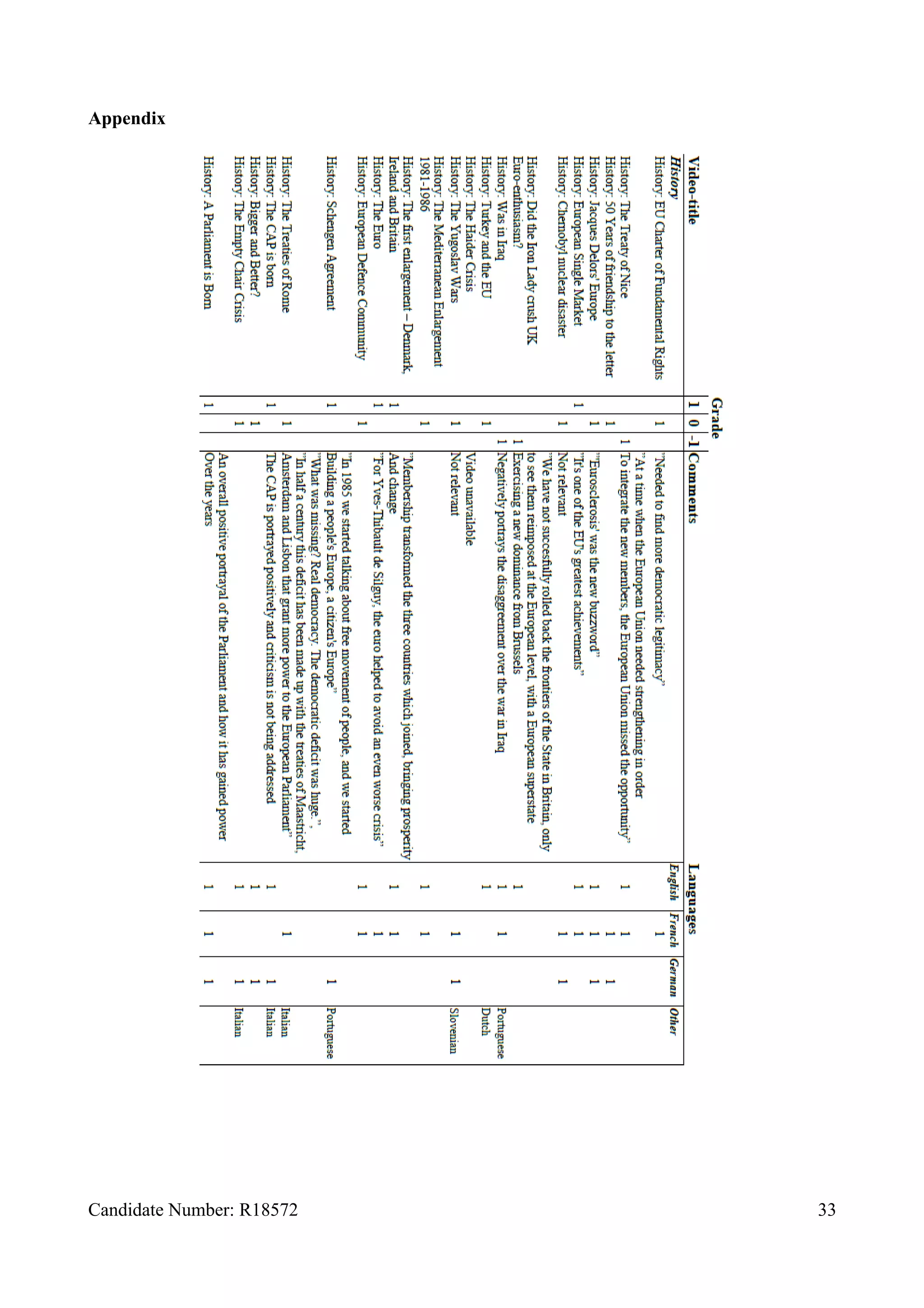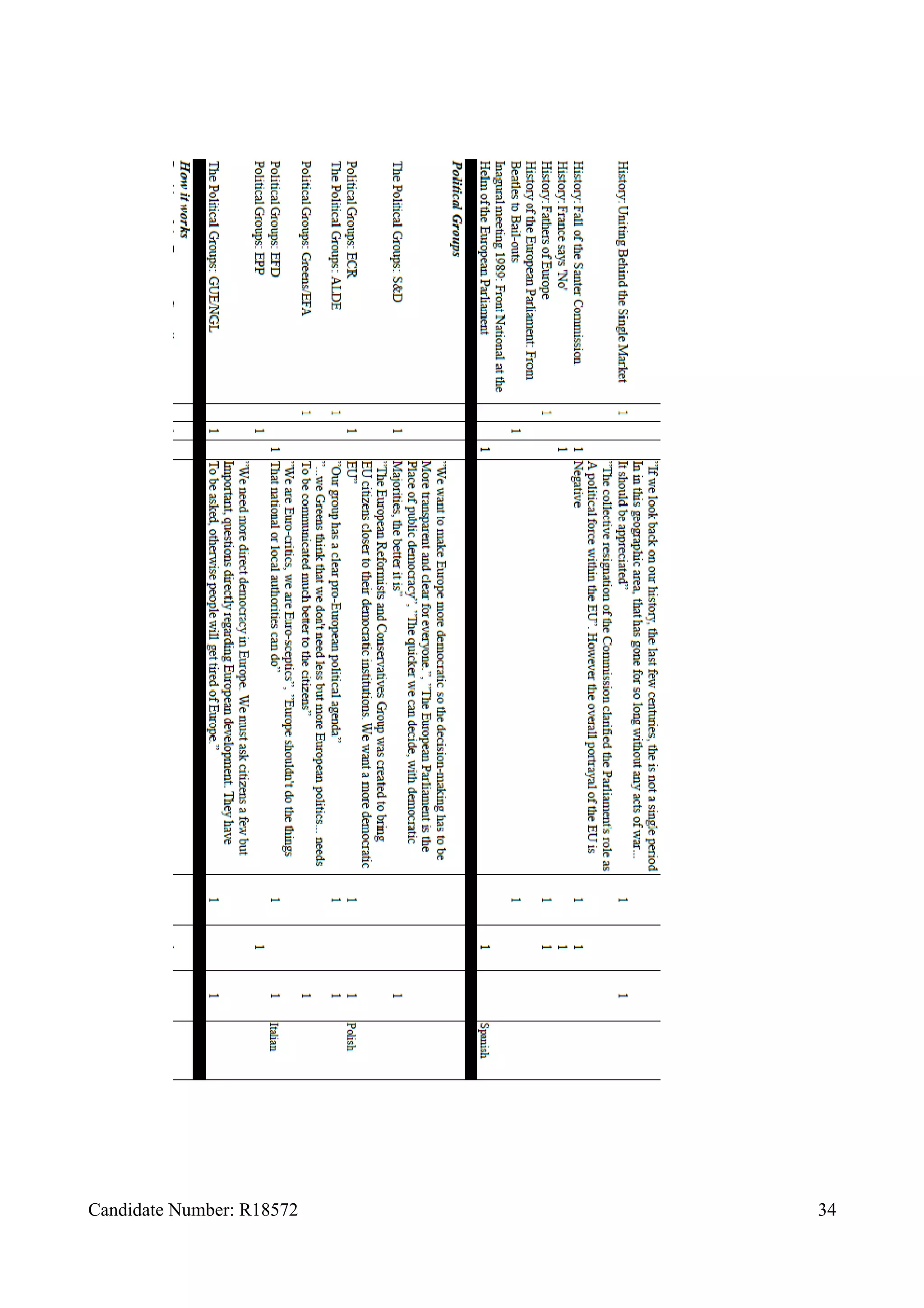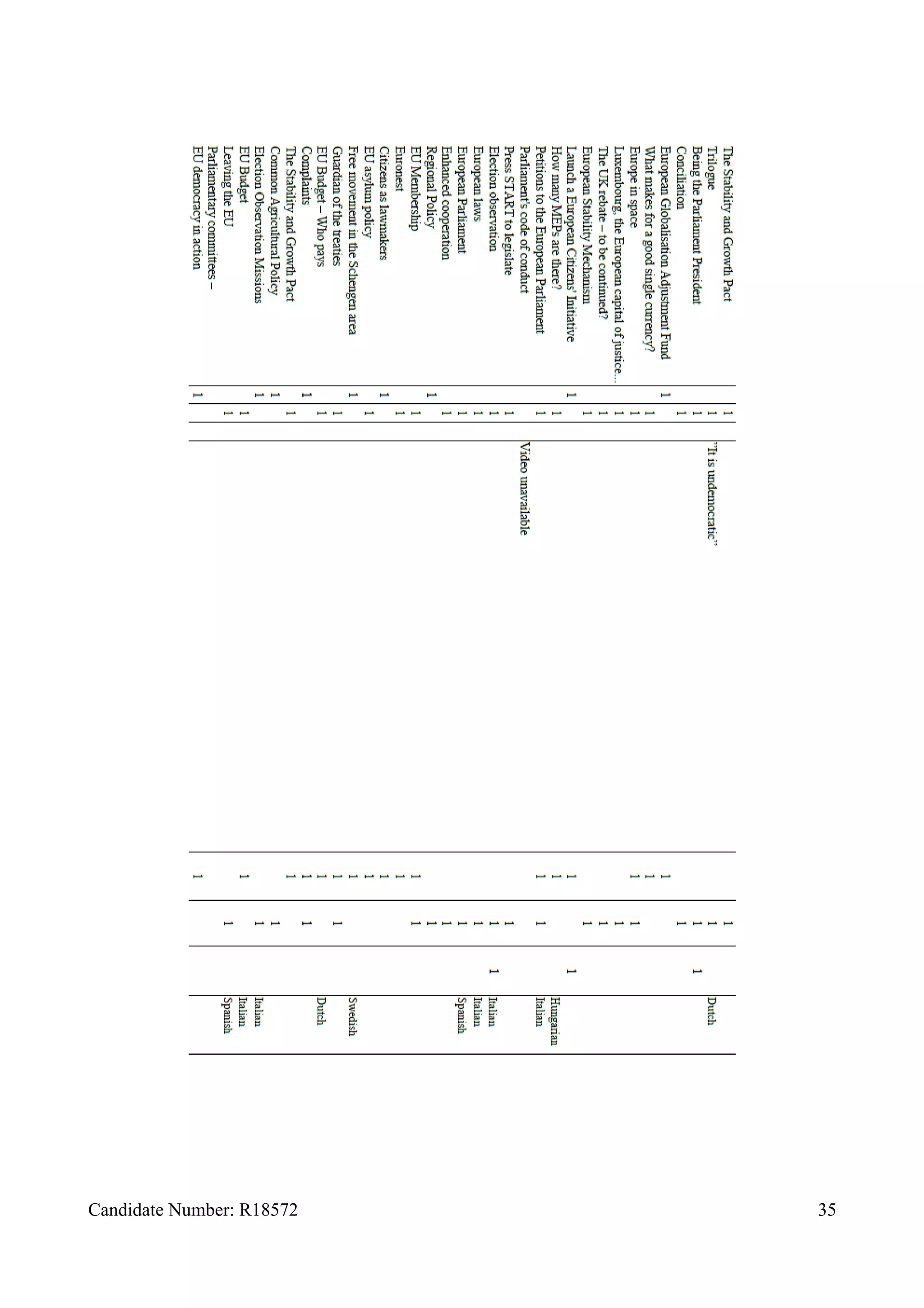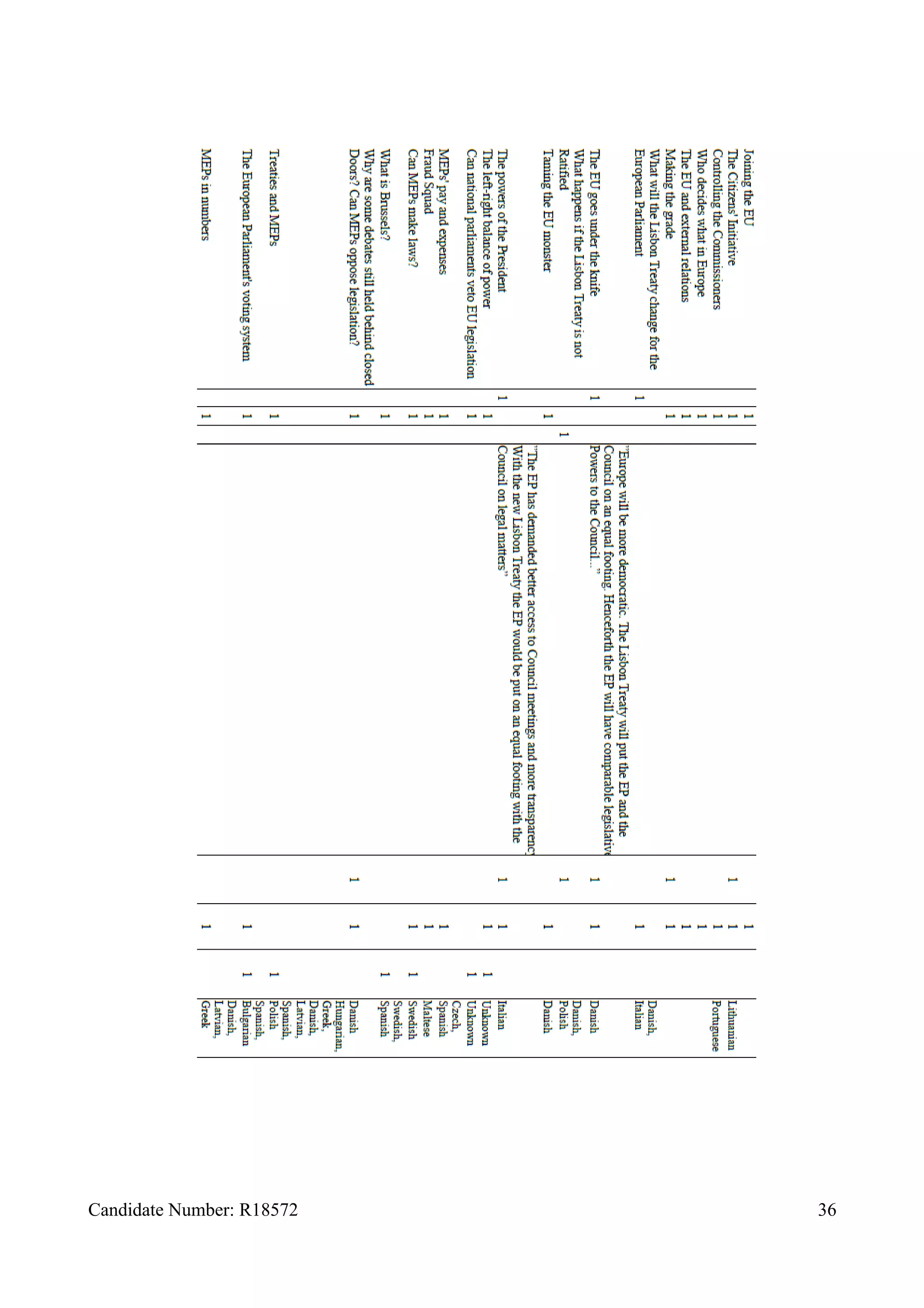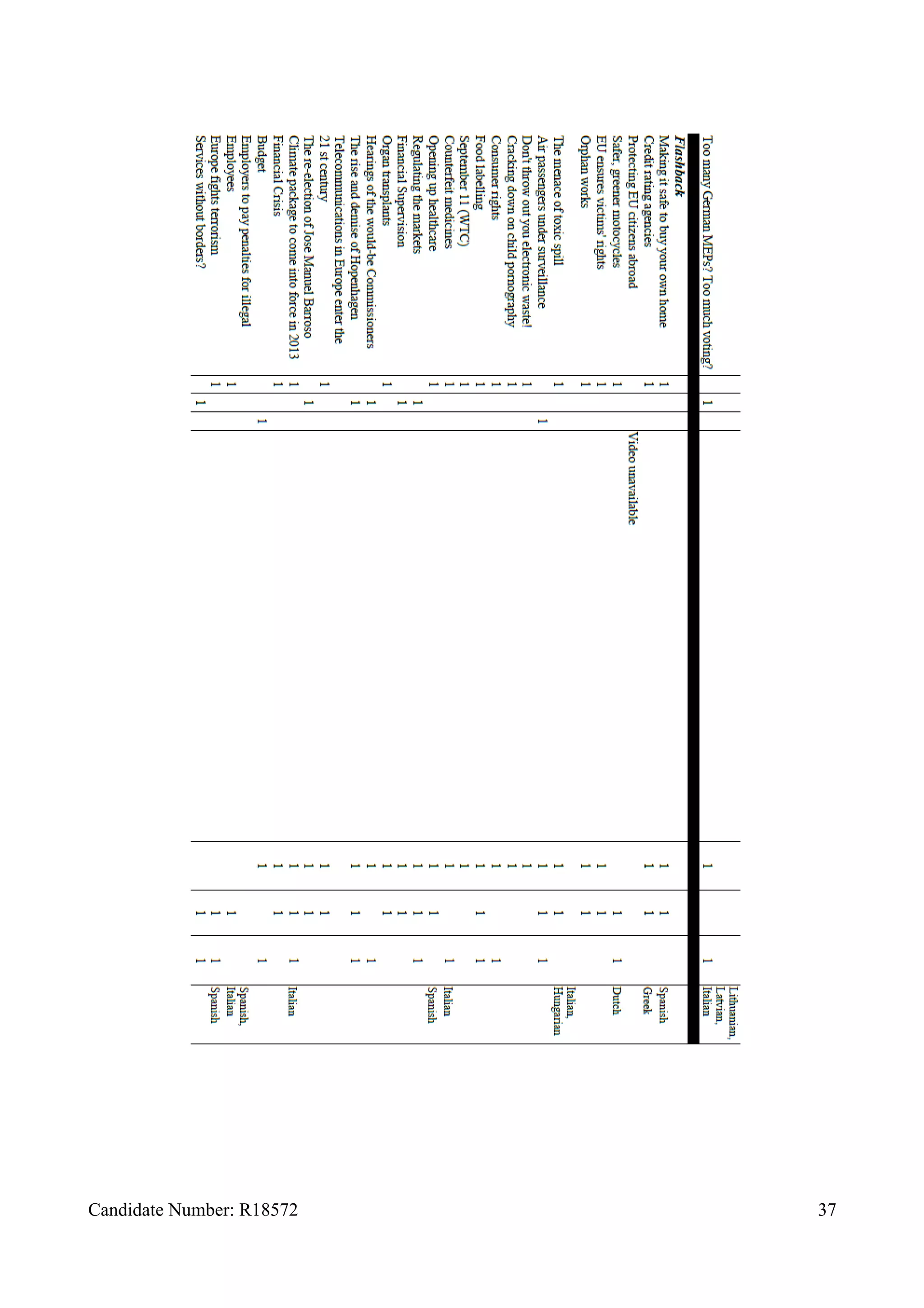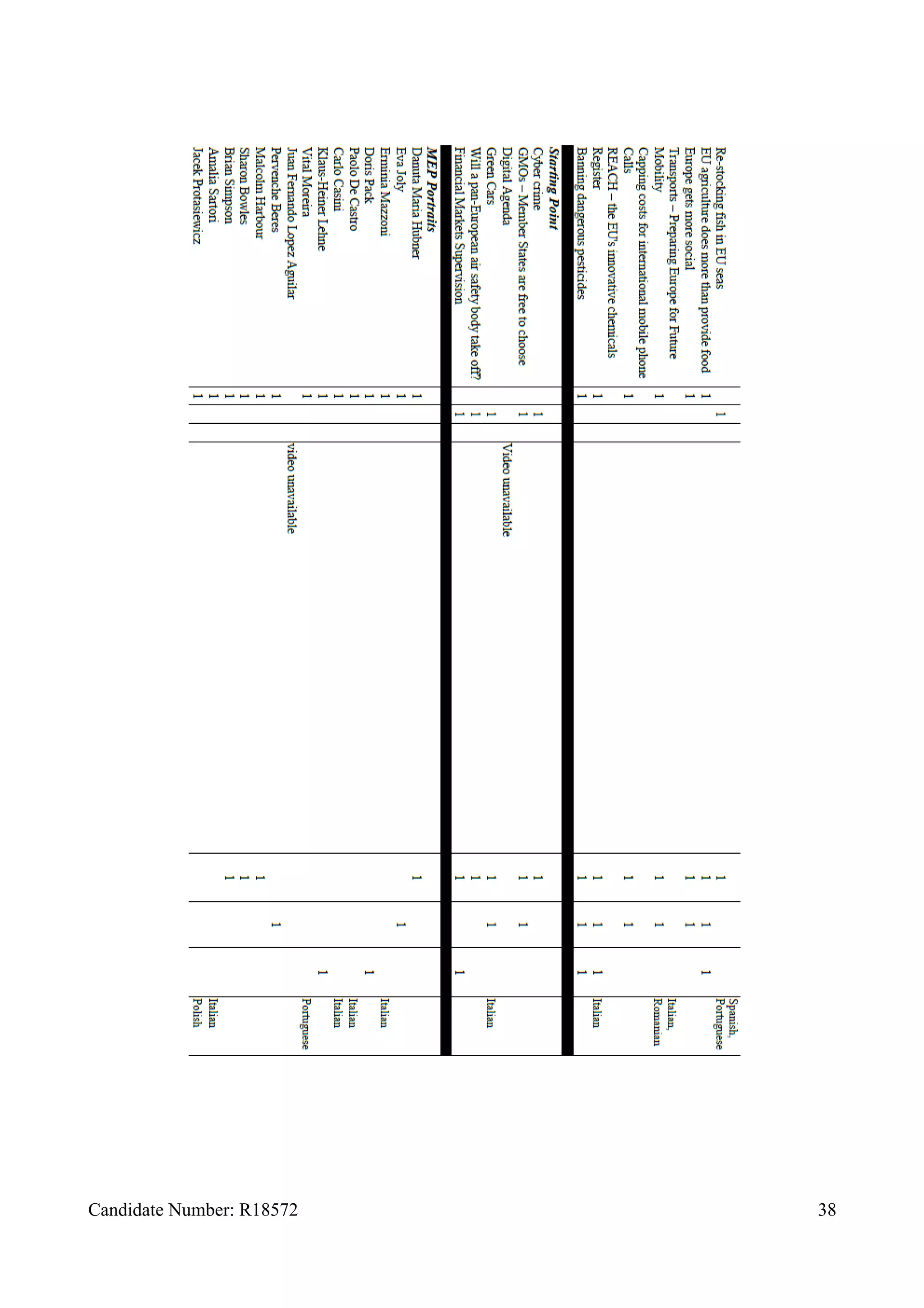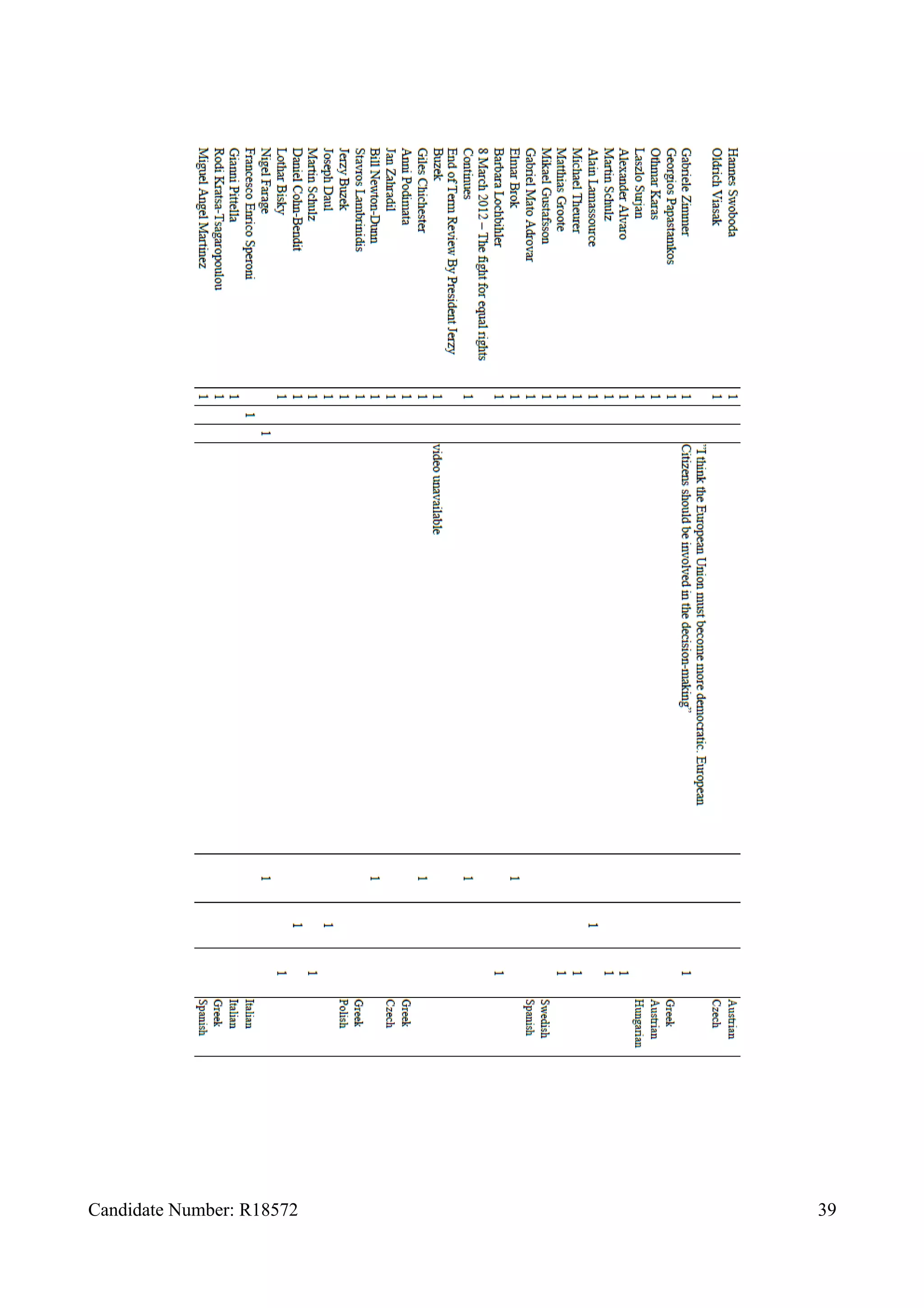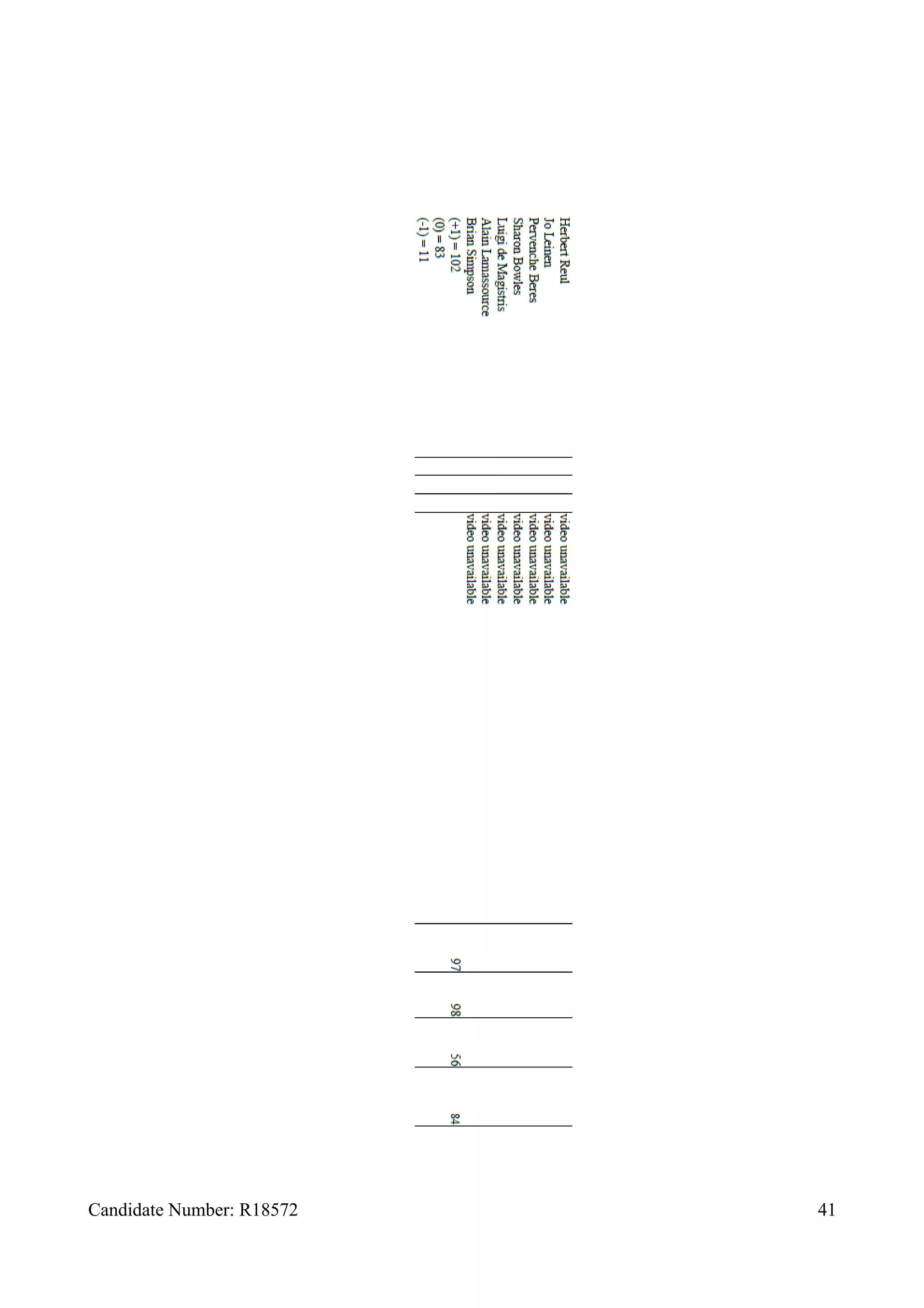This document summarizes a dissertation that examines the European Parliament's use of its internet television channel, EuroparlTV, to address its communicative deficit with citizens. Through a case study of the EuroparlTV sub-channel "Discover Parliament", the dissertation finds that the Parliament is reluctant to discuss its own role in the democratic deficit or provide solutions to resolve it. The dissertation recommends that the Parliament more openly recognize the democratic deficit and empower citizens to help resolve it.
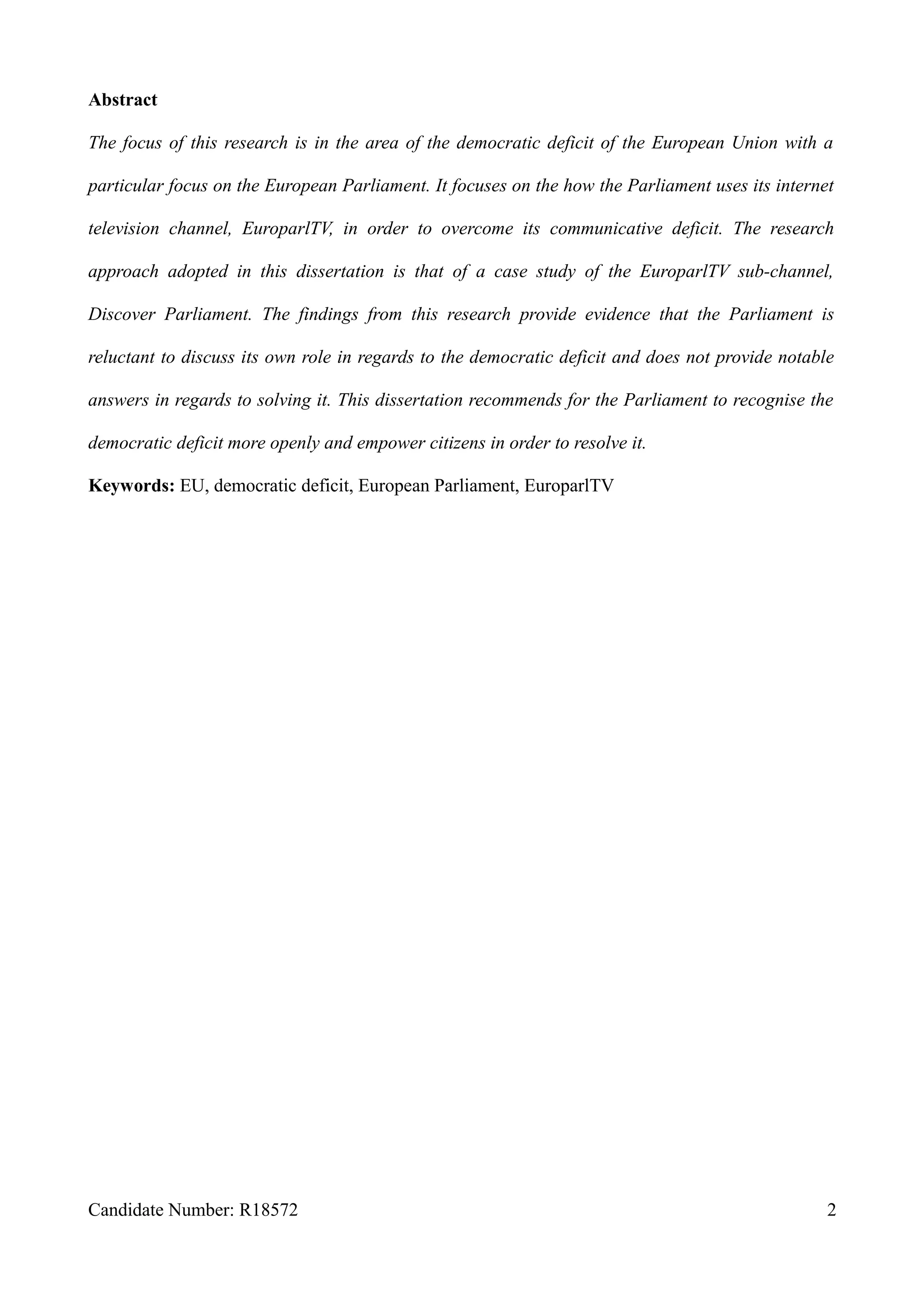
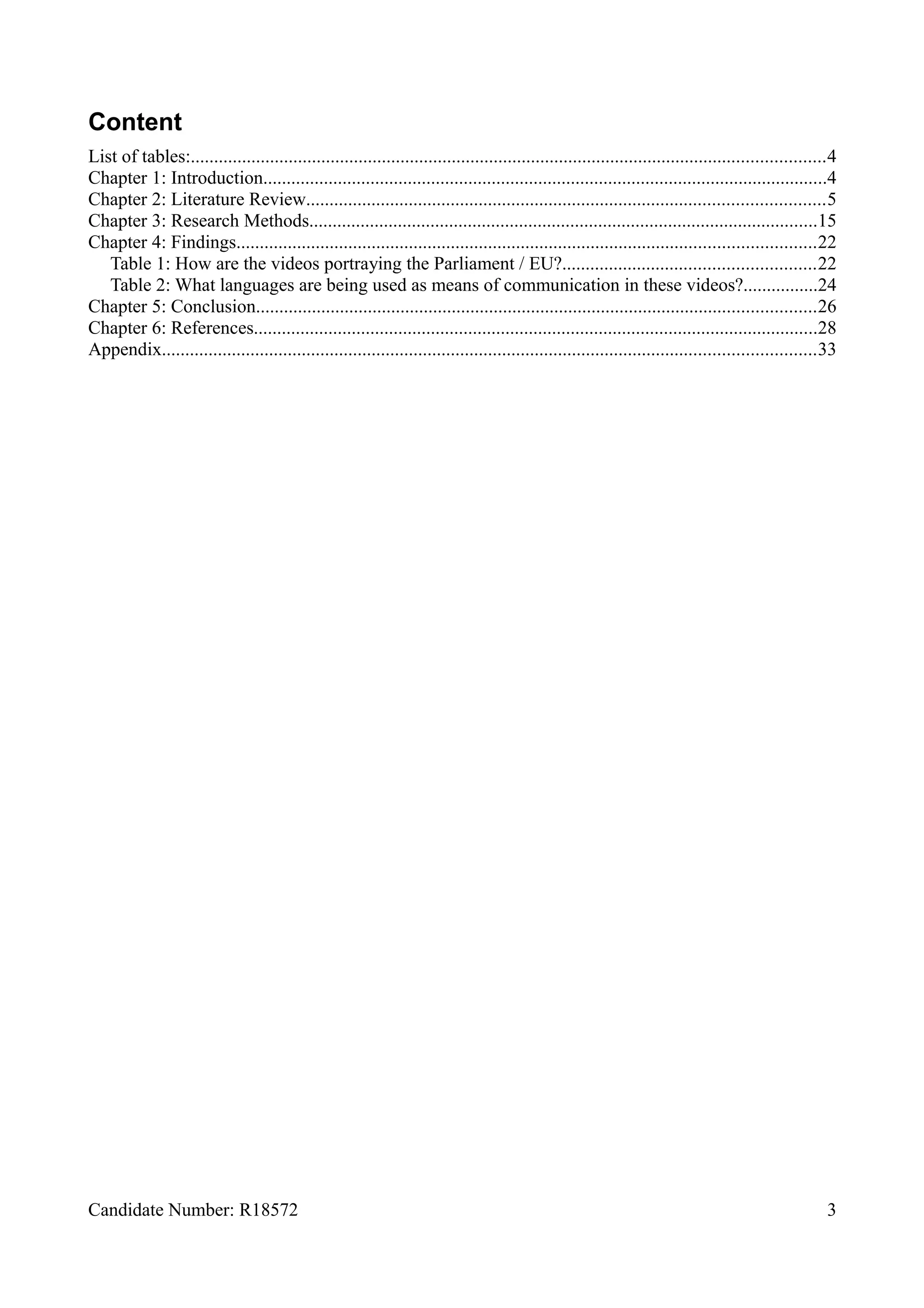
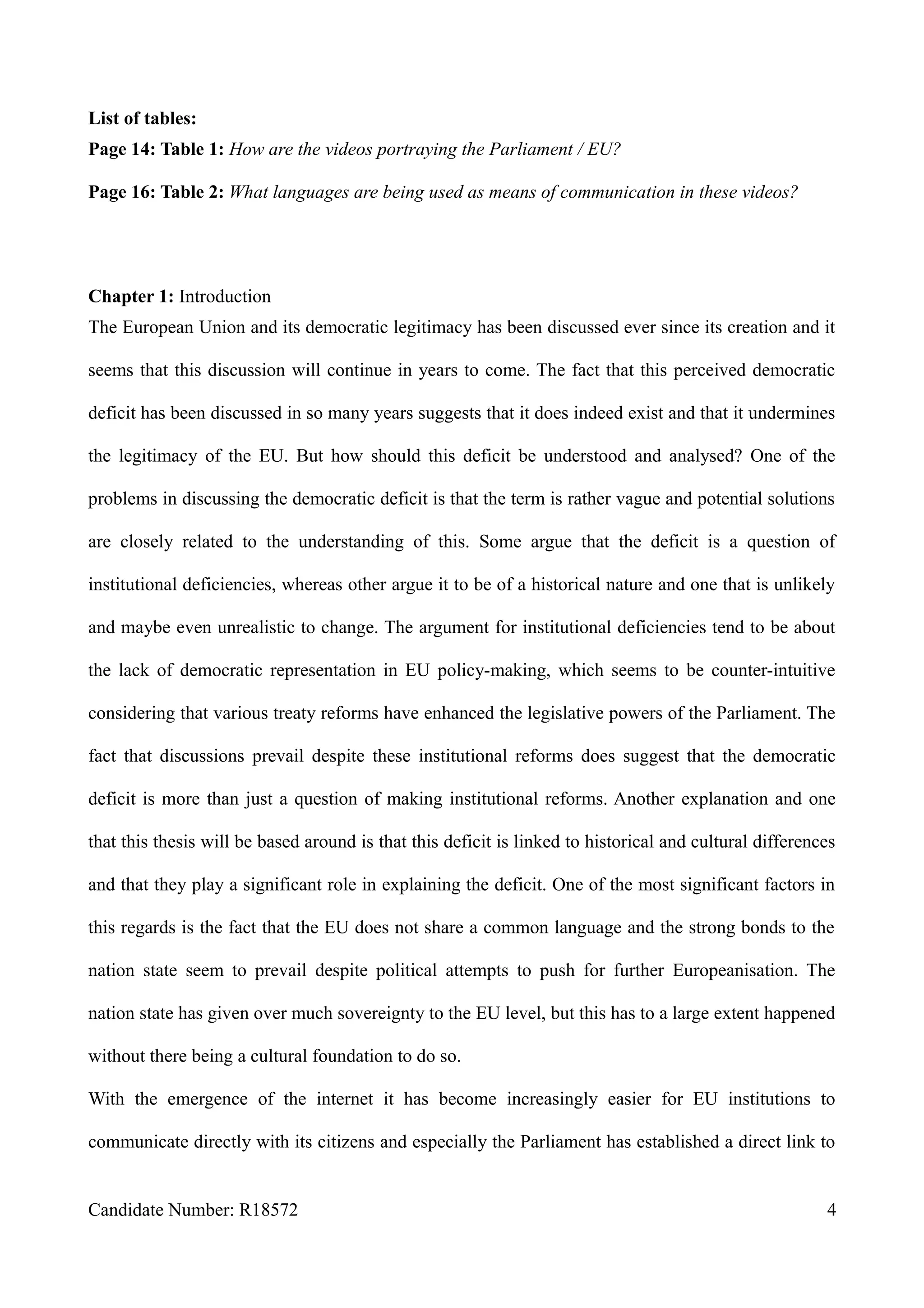
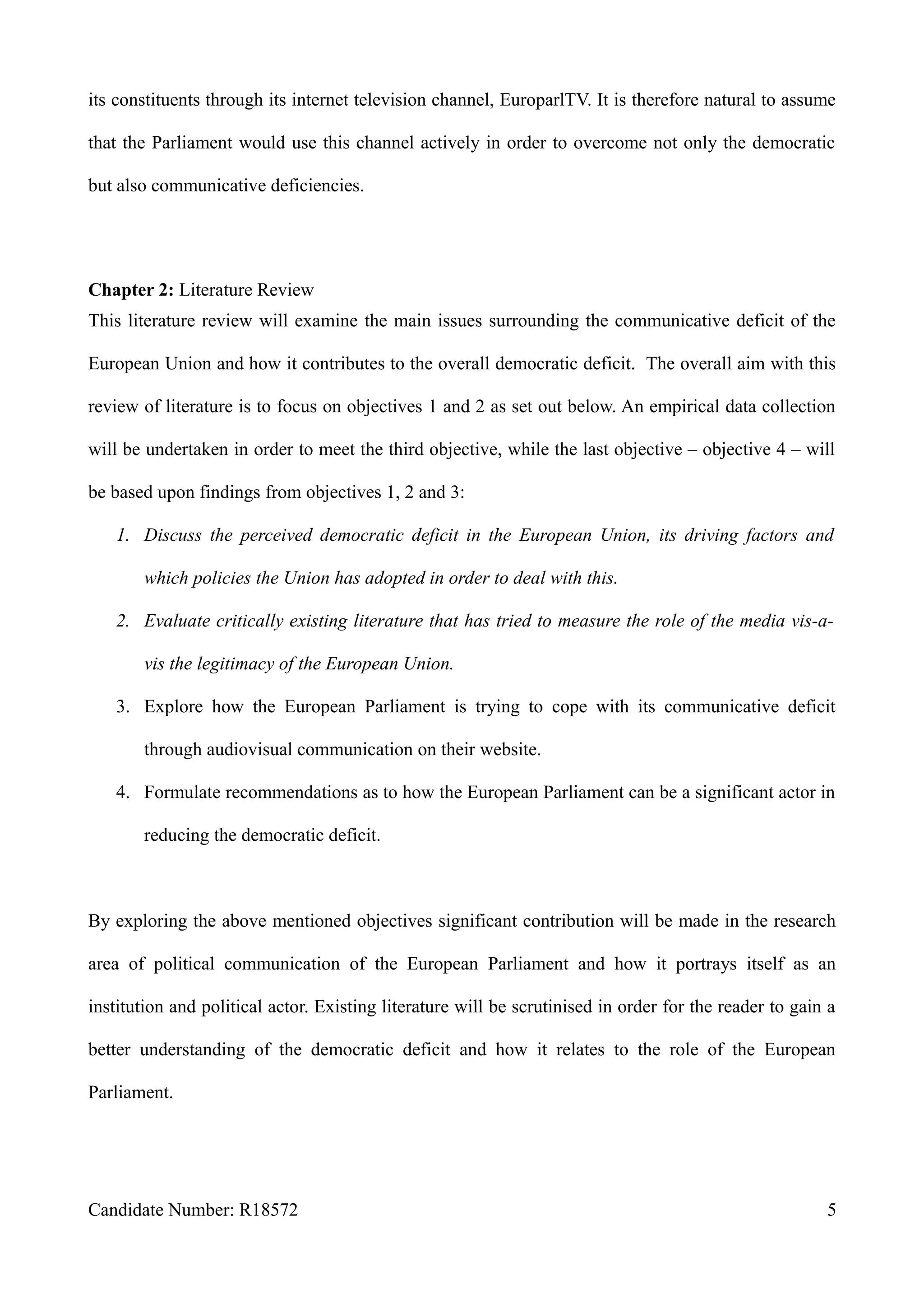

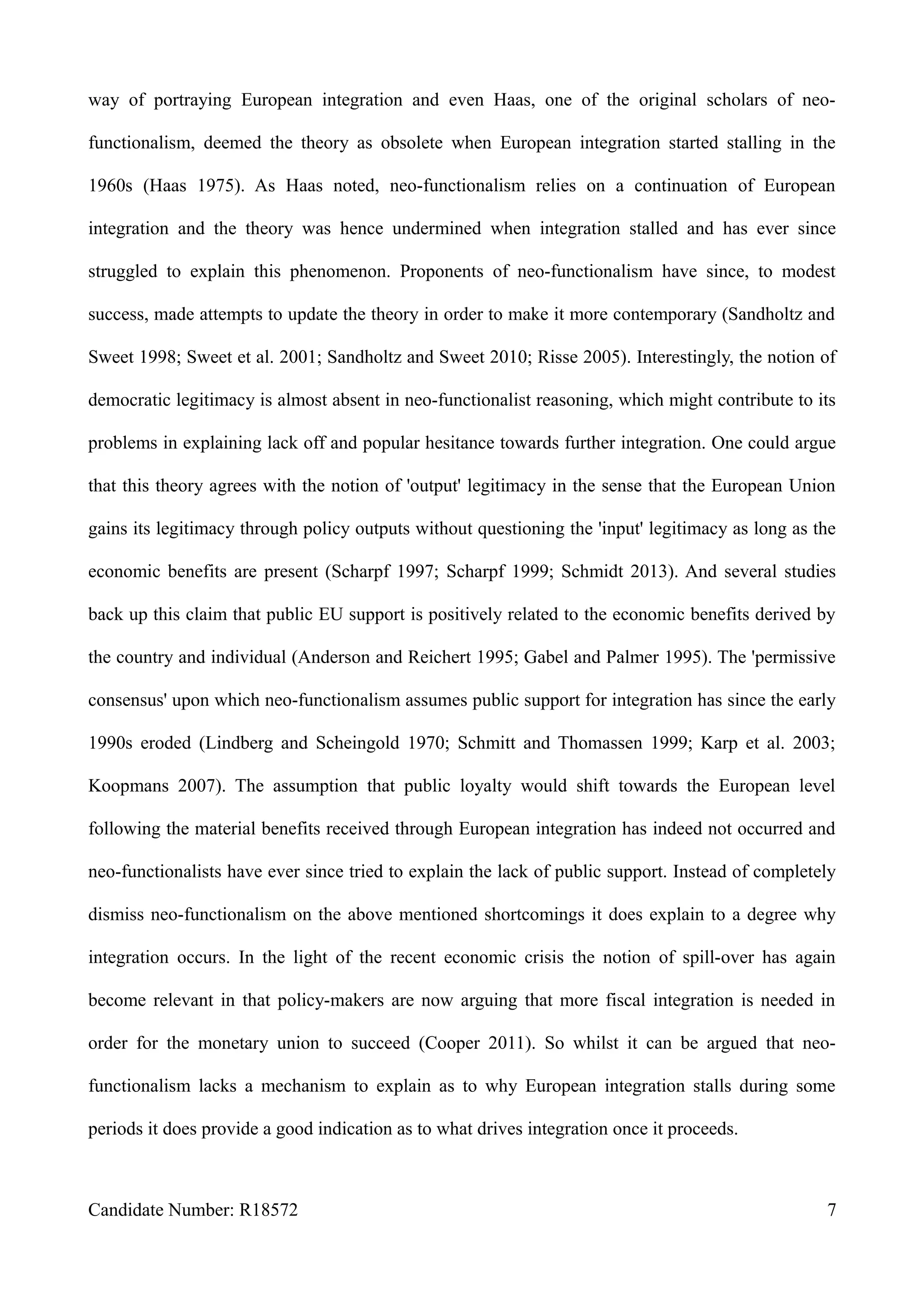

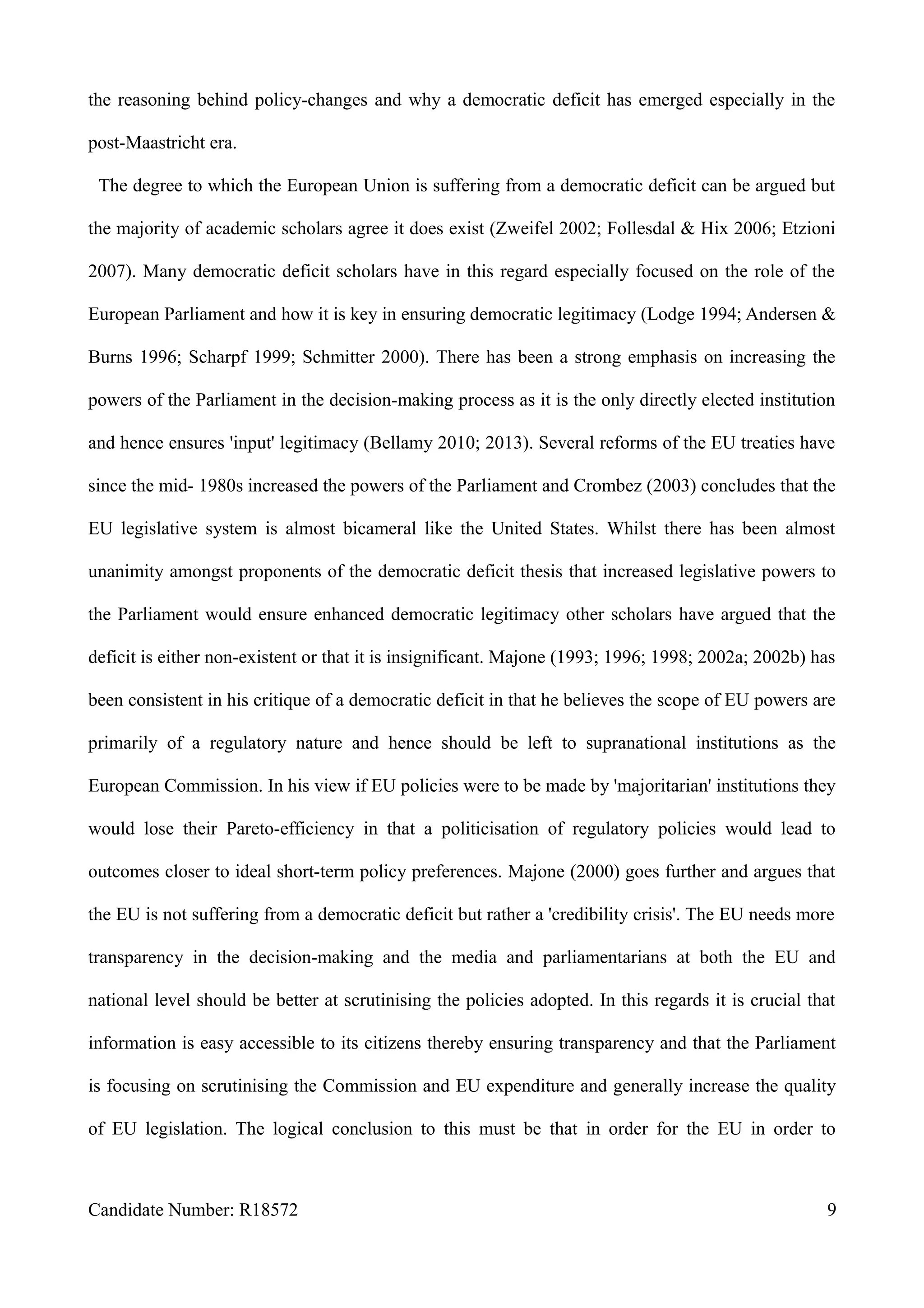
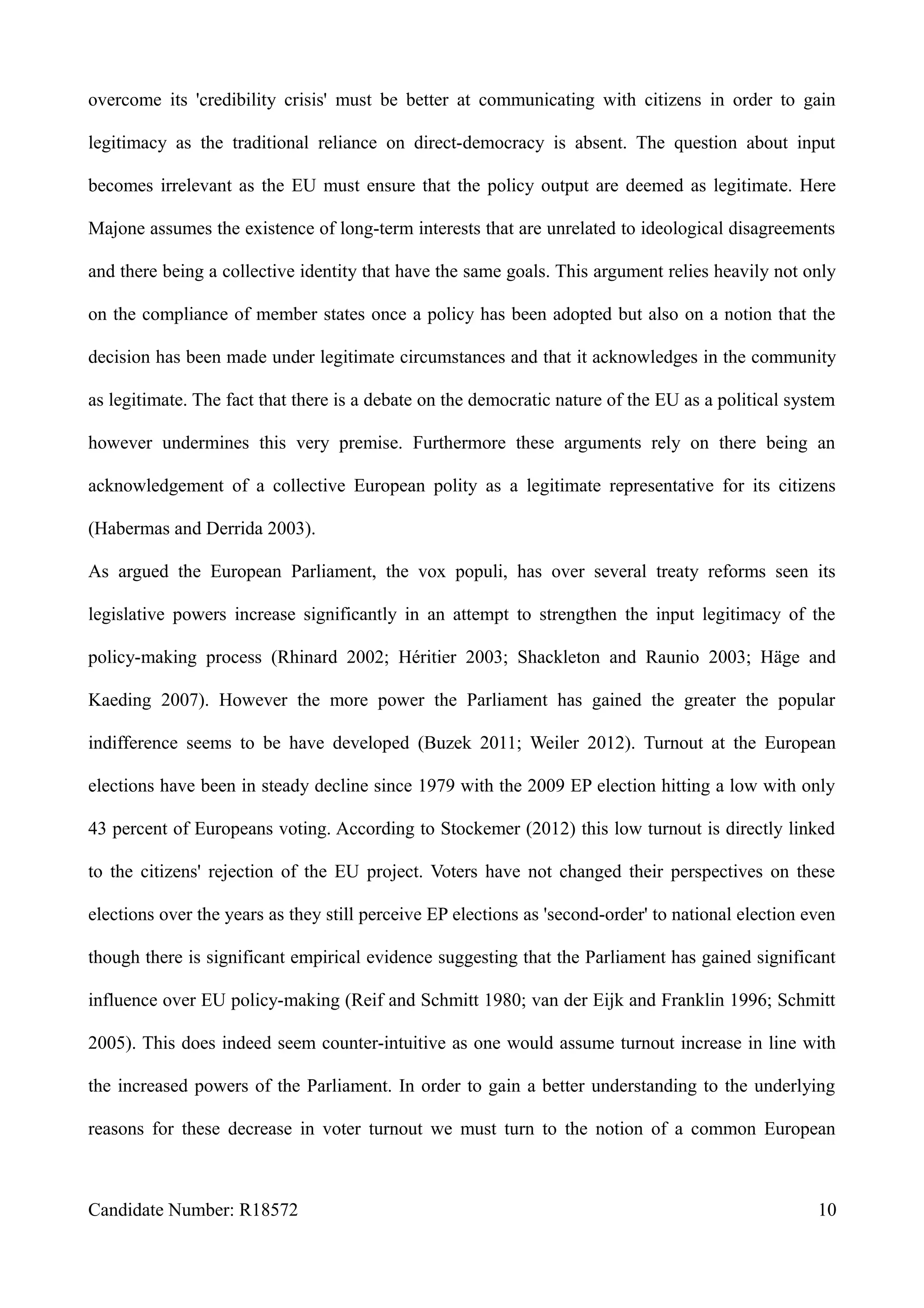
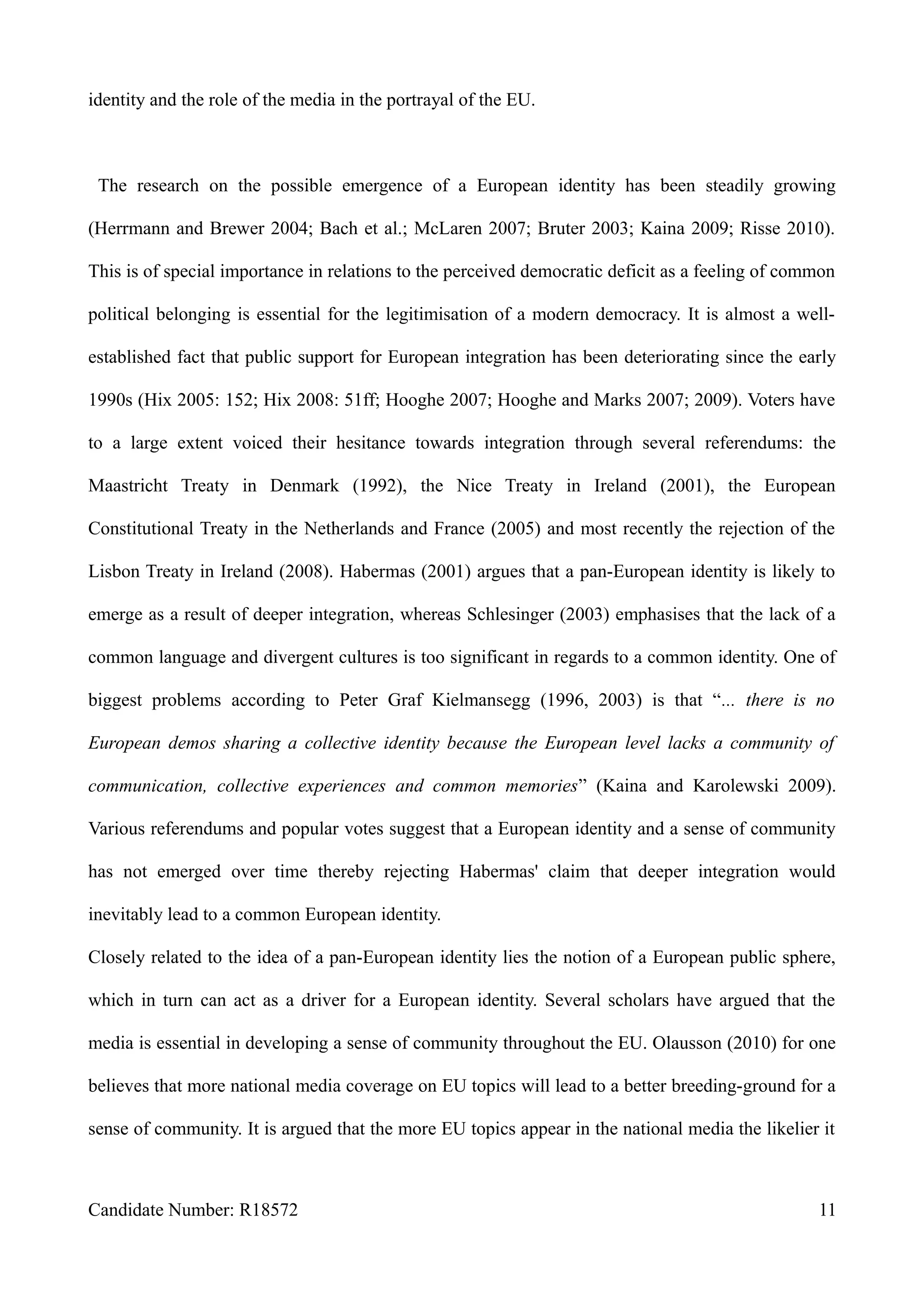
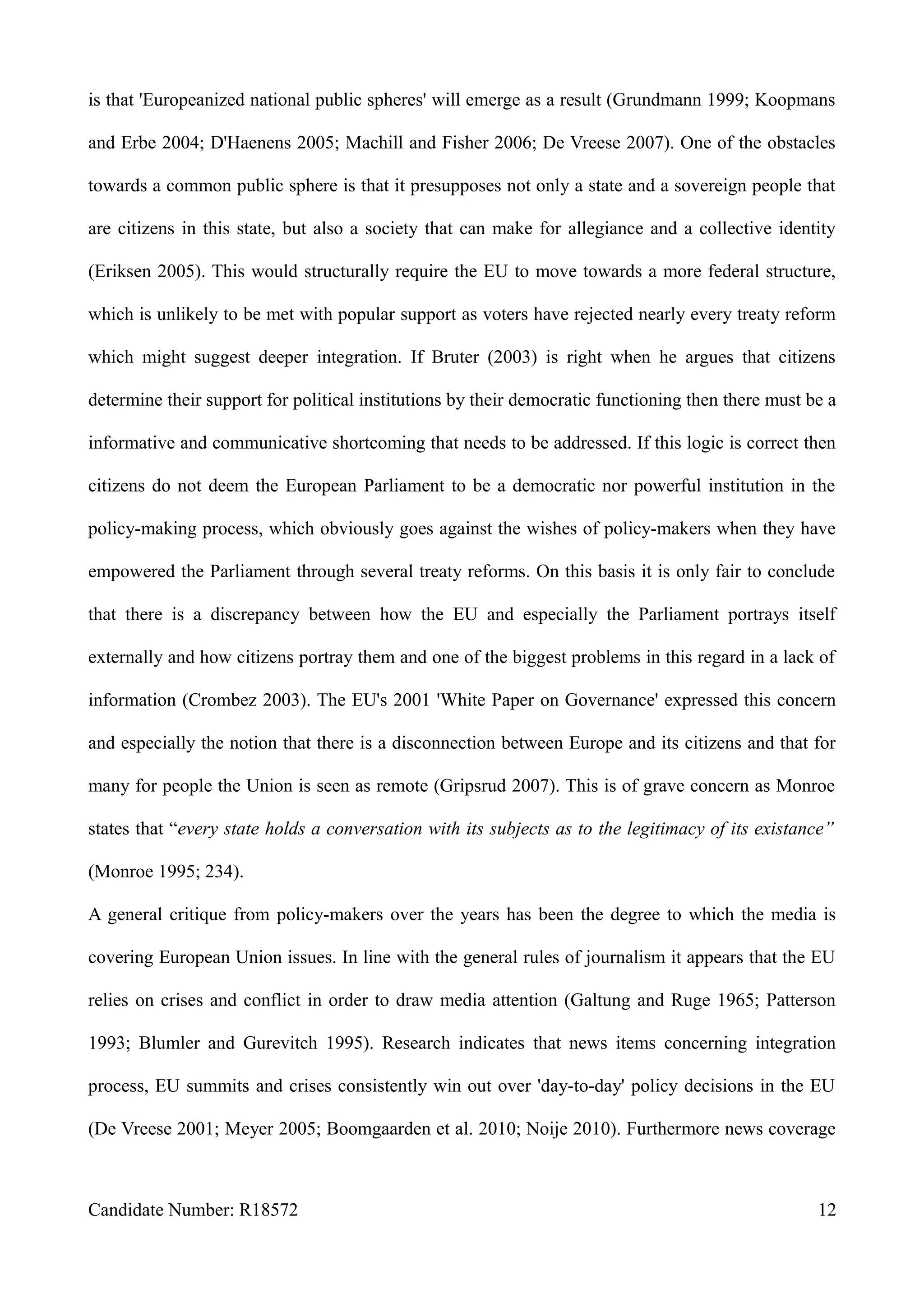
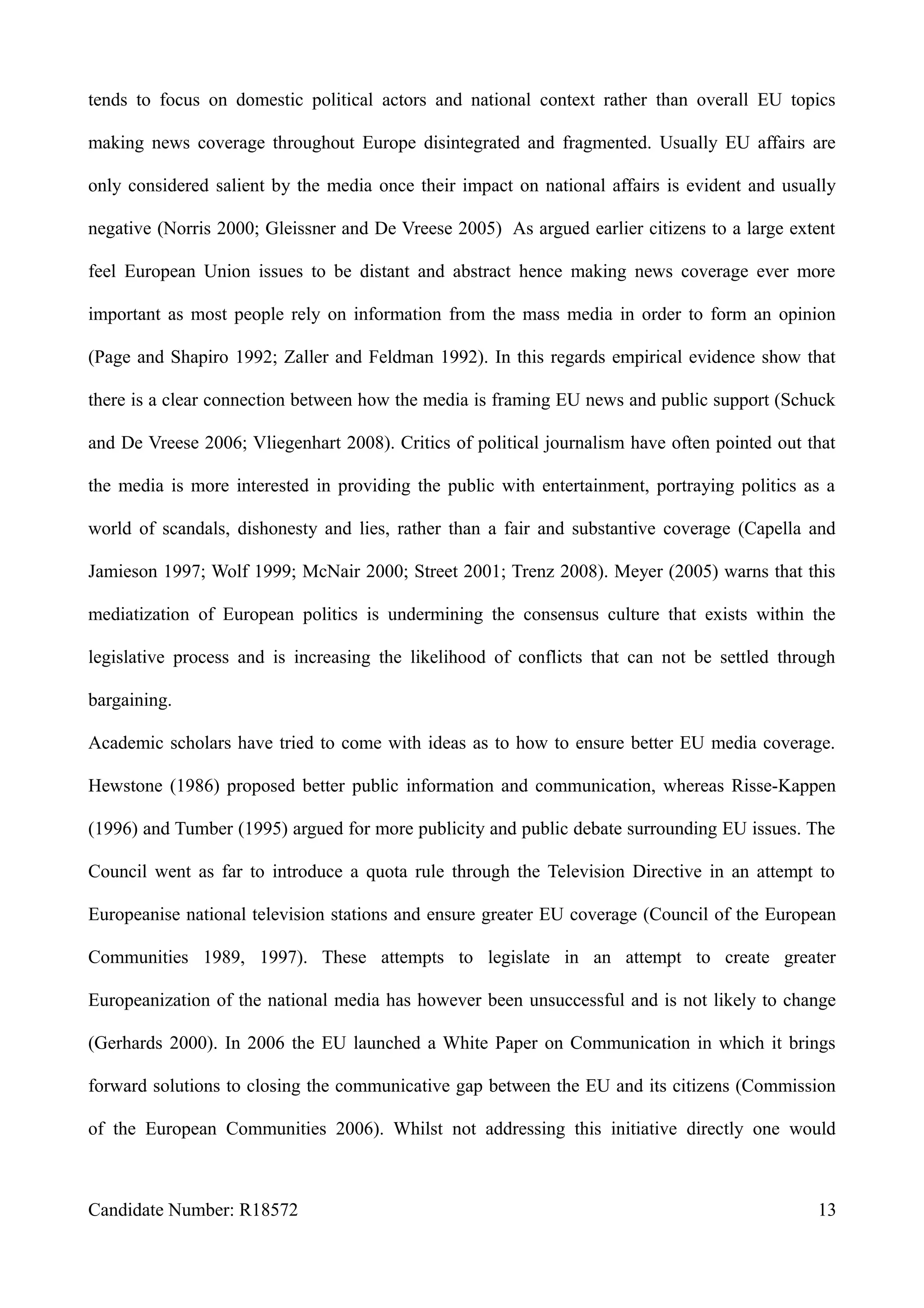
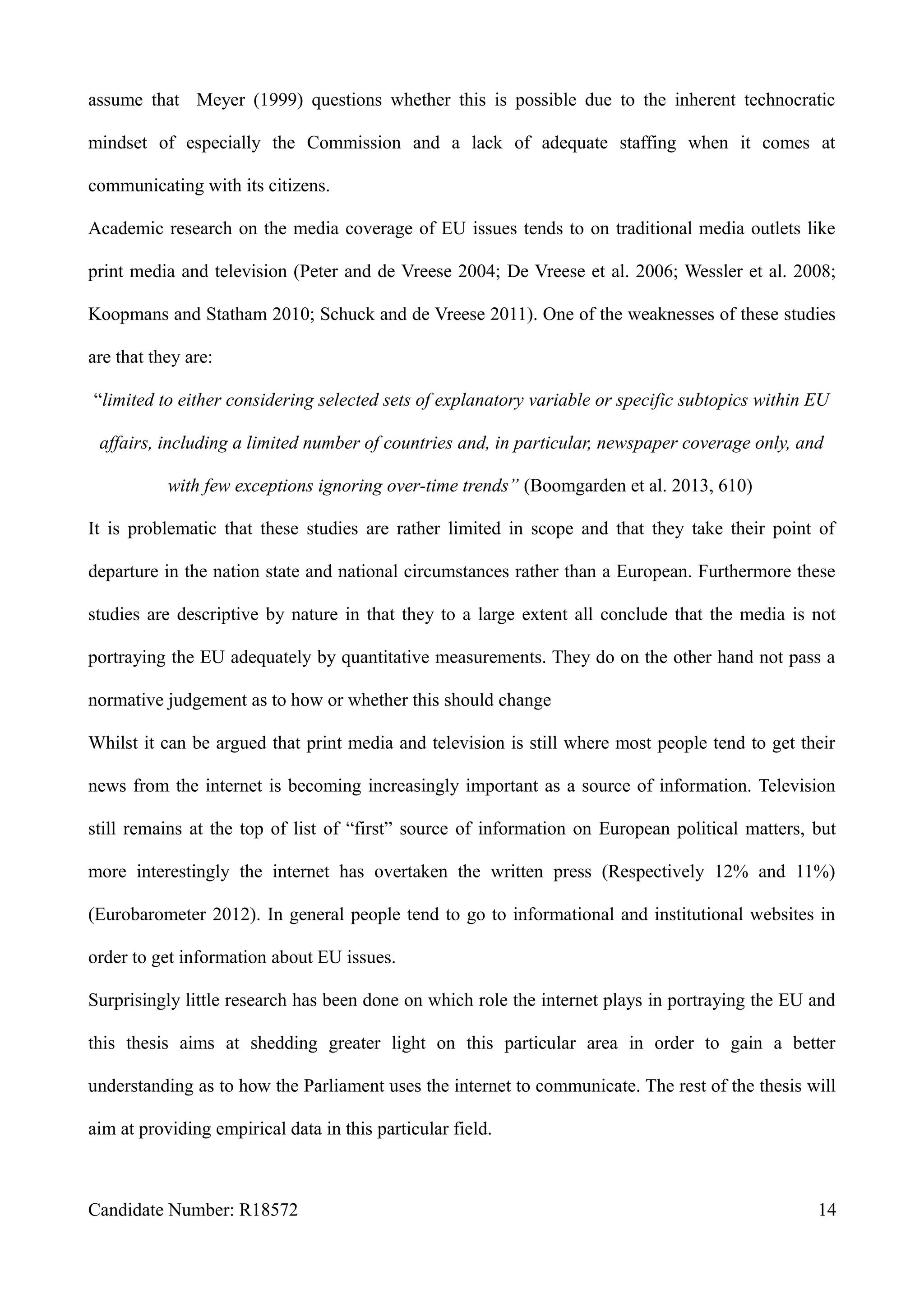

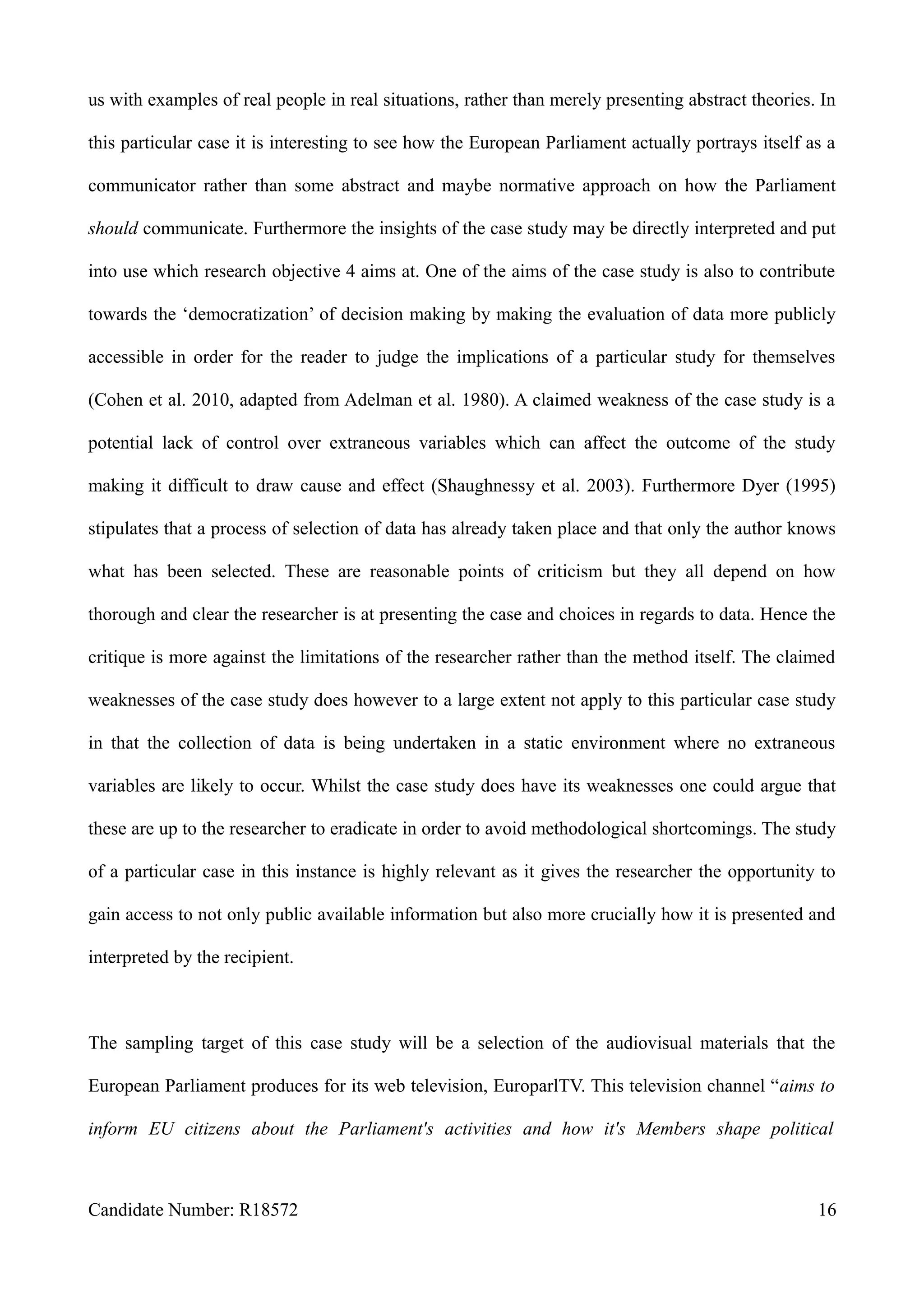
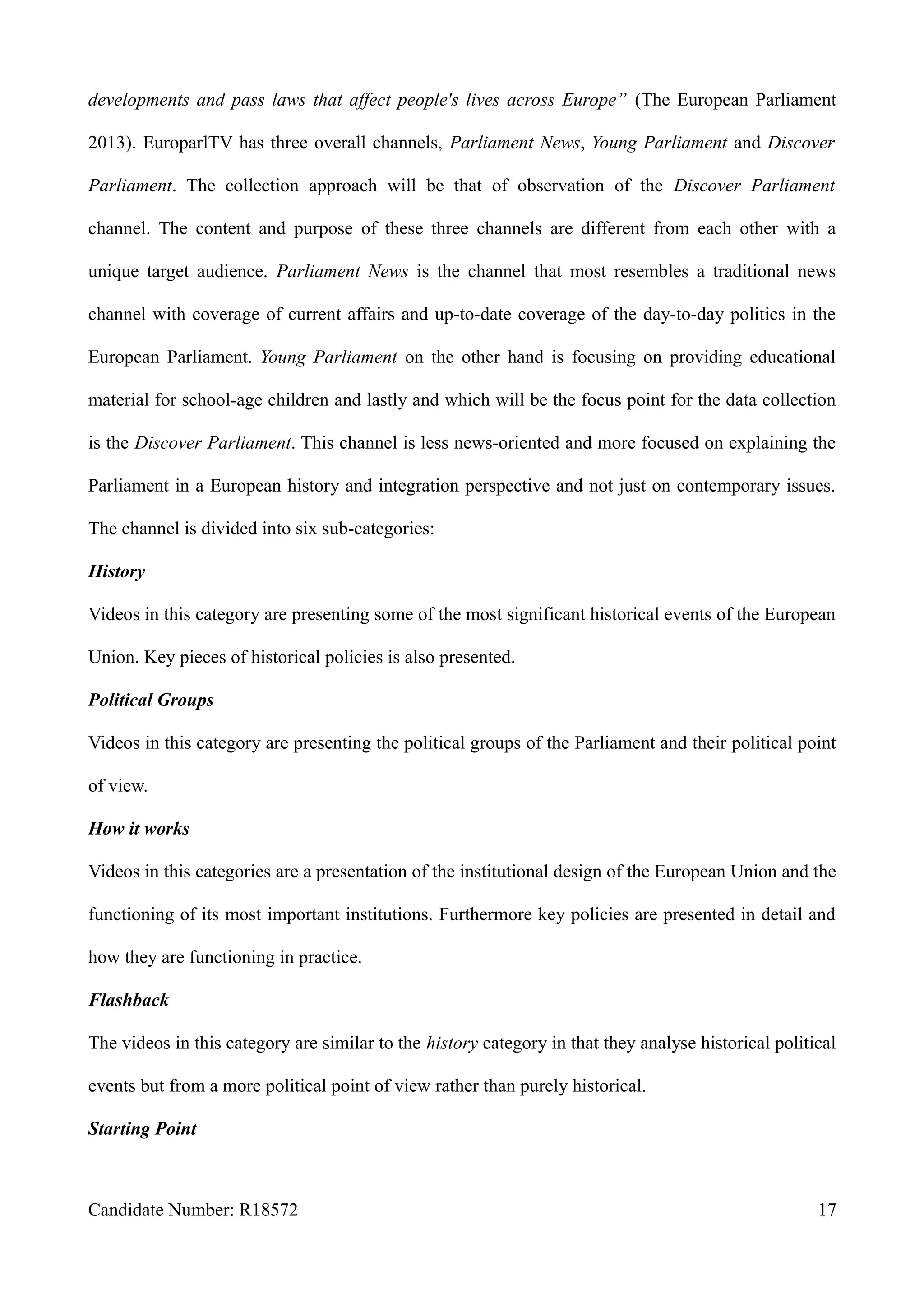
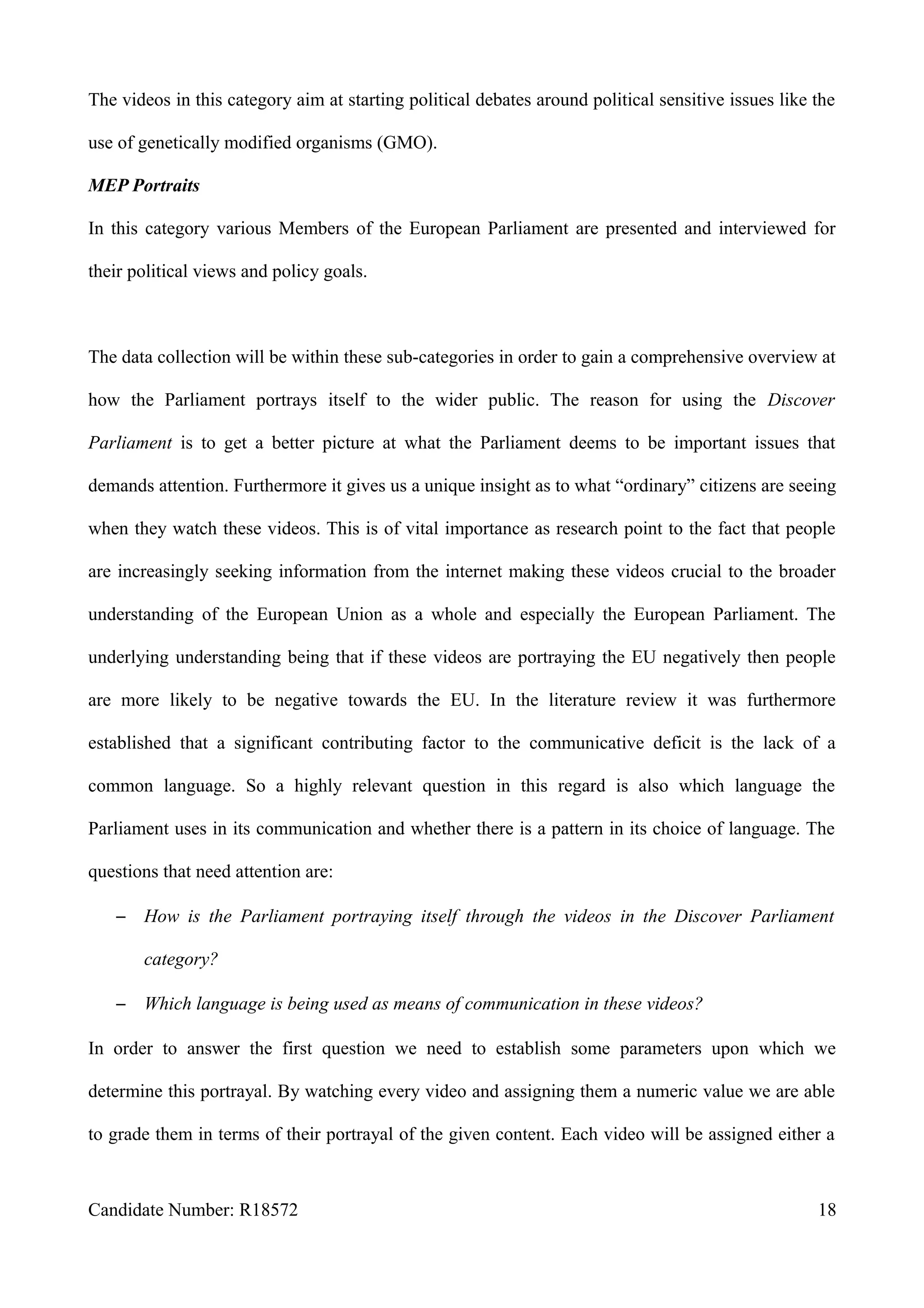
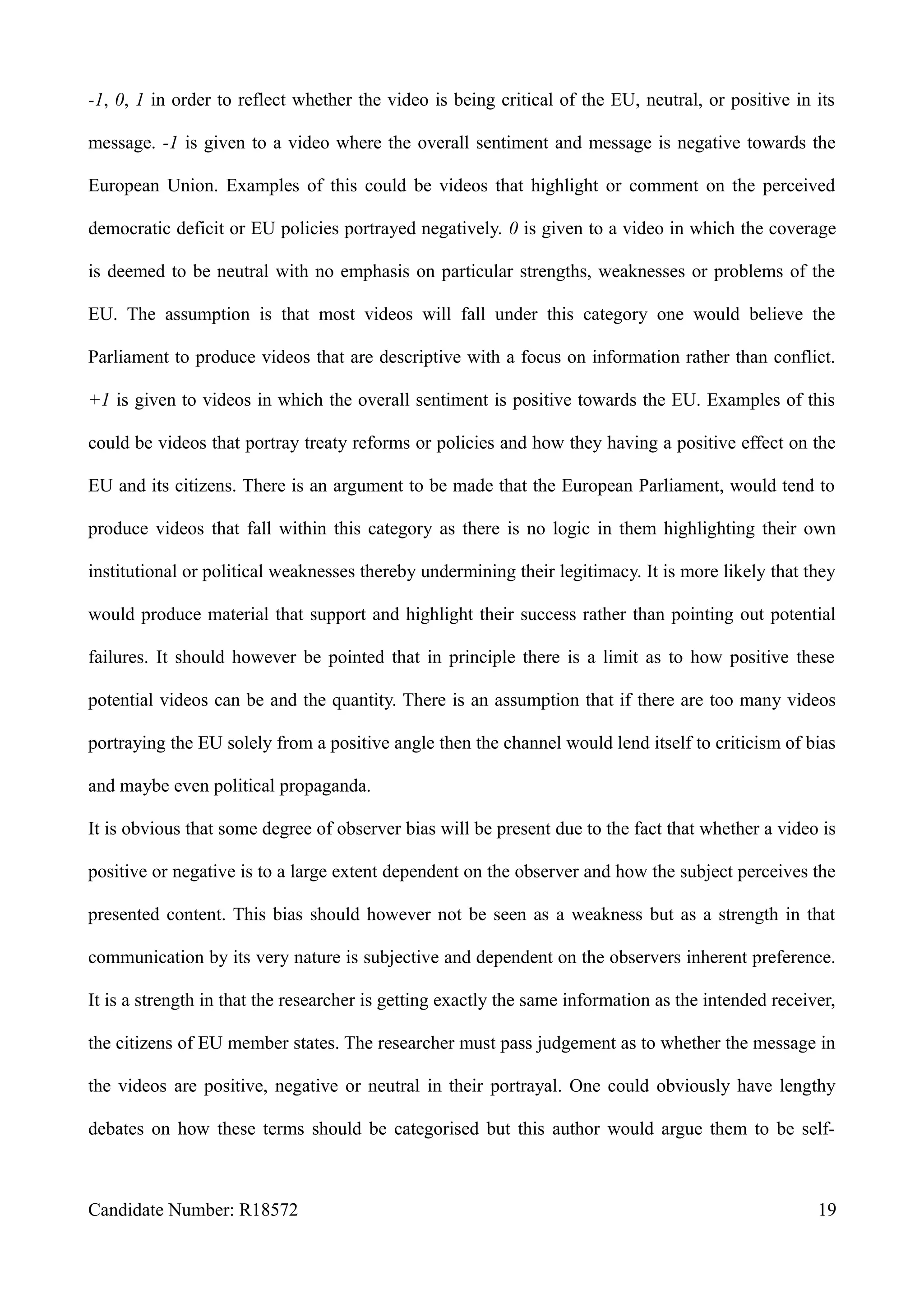
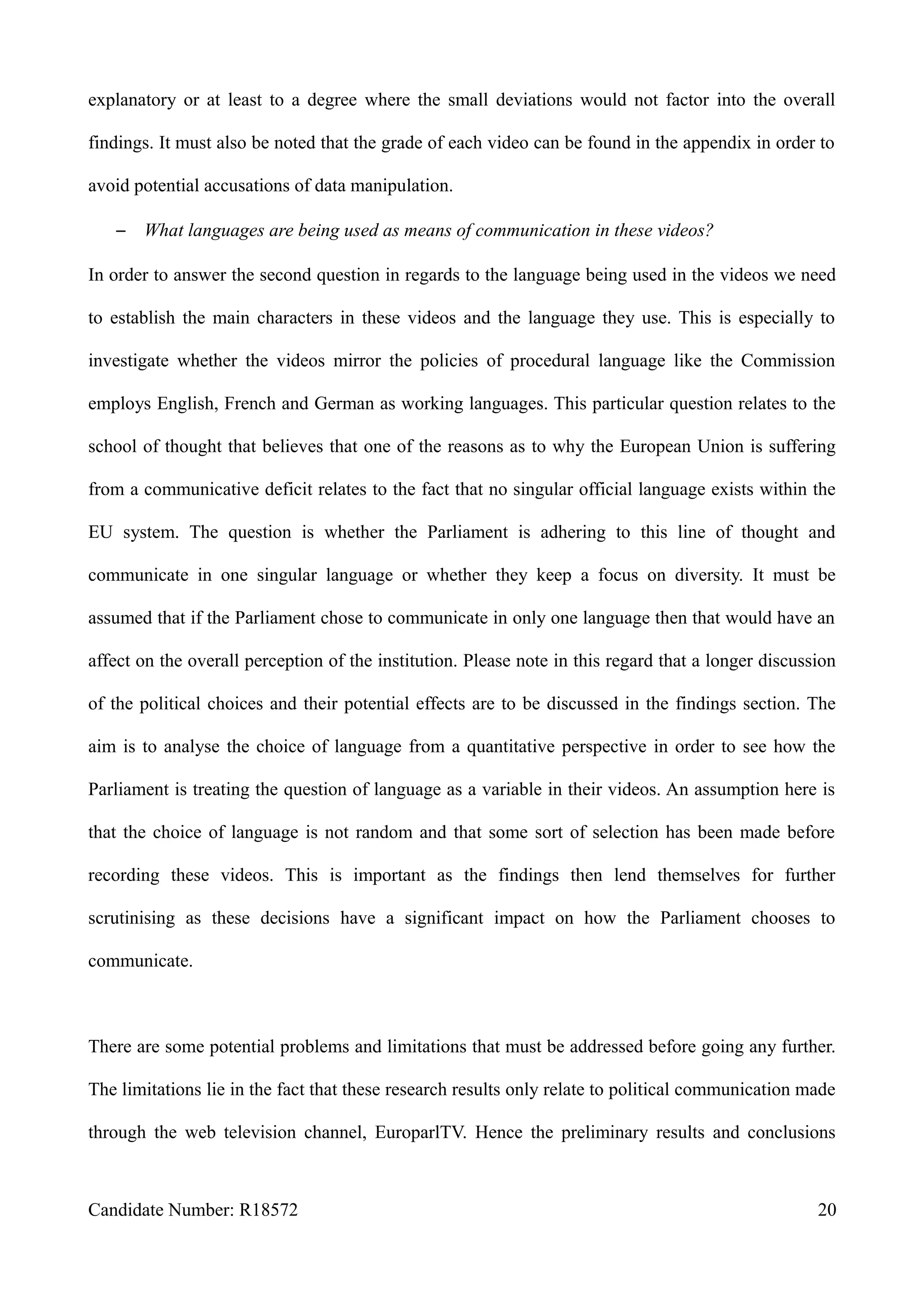
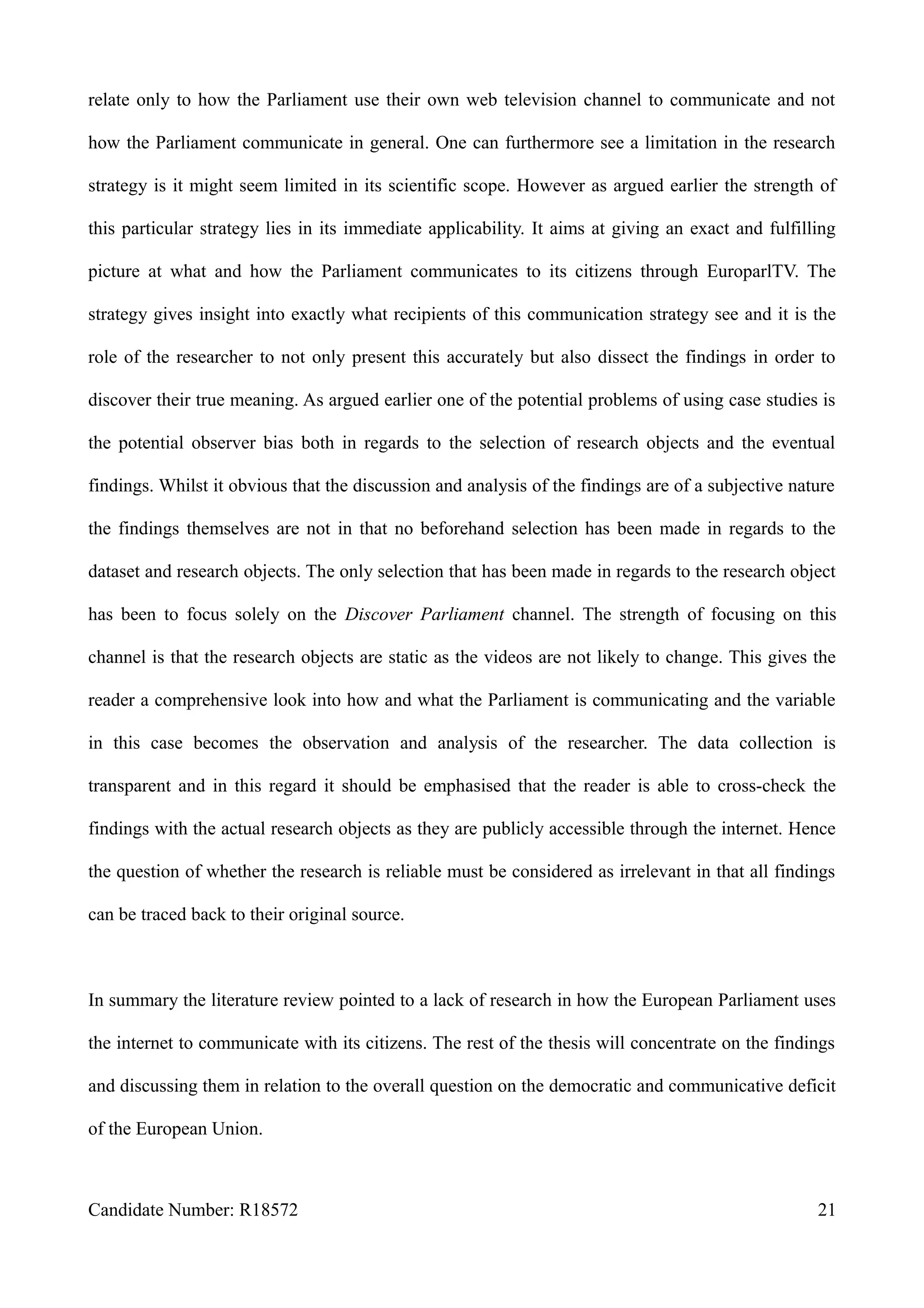
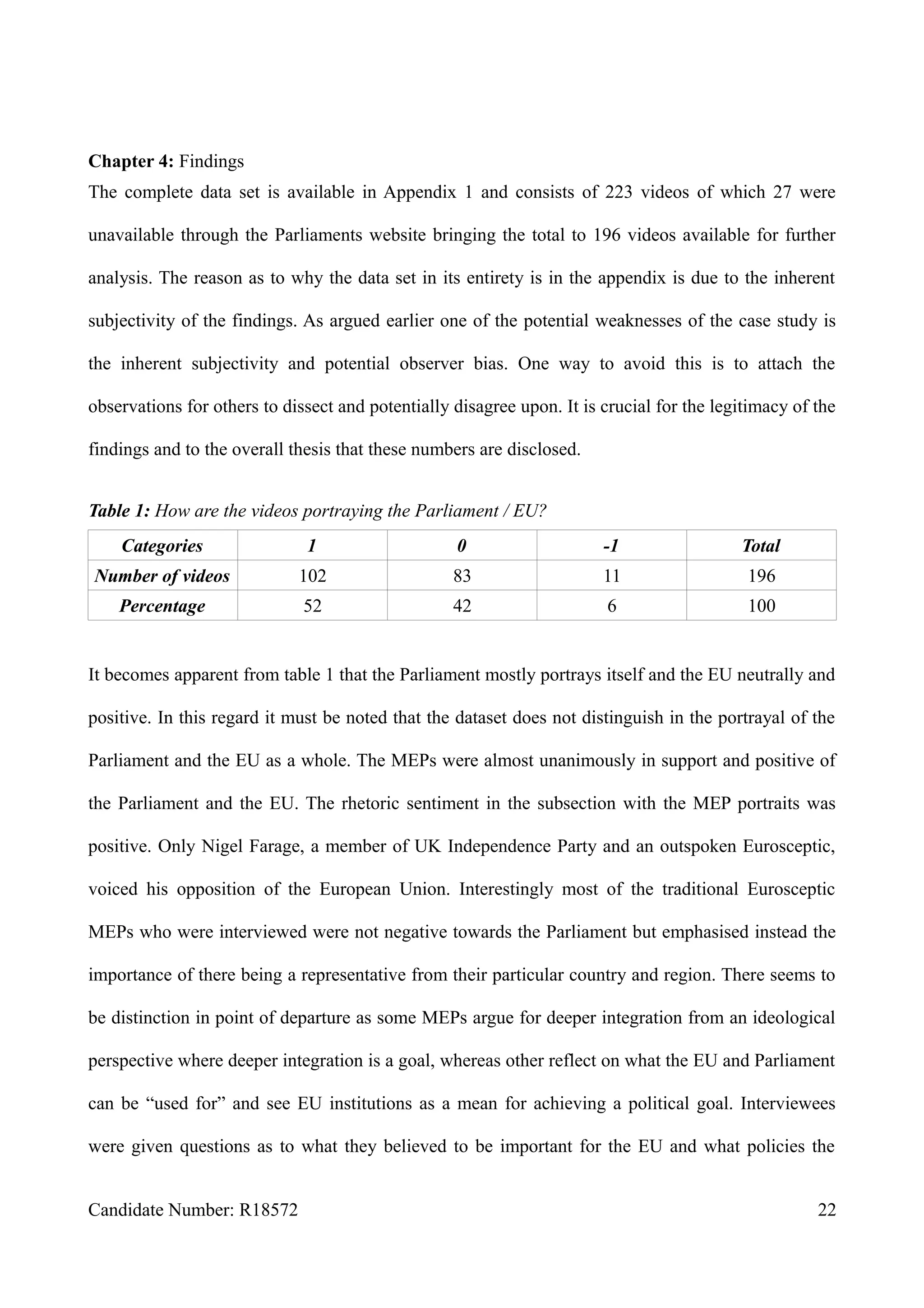
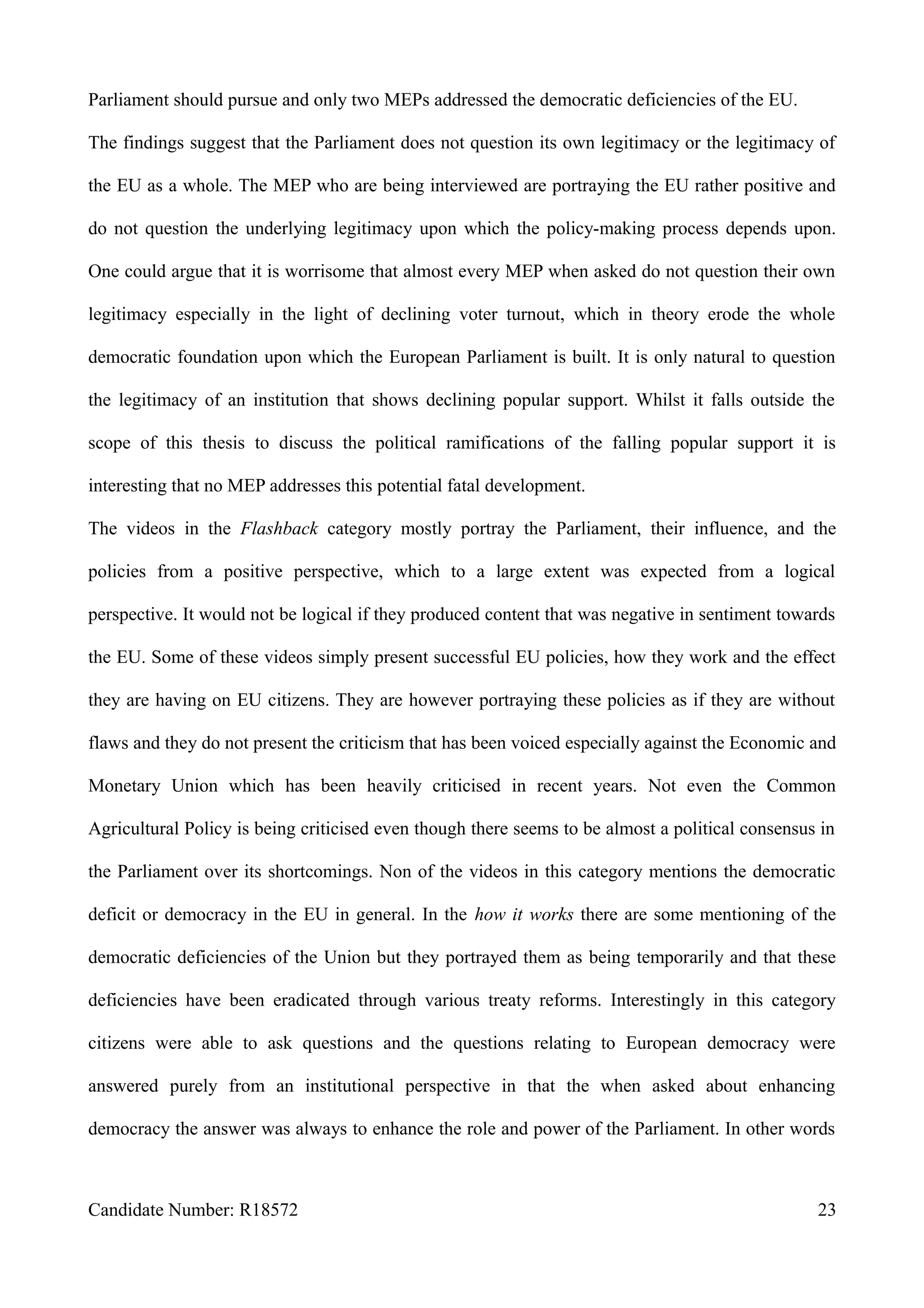

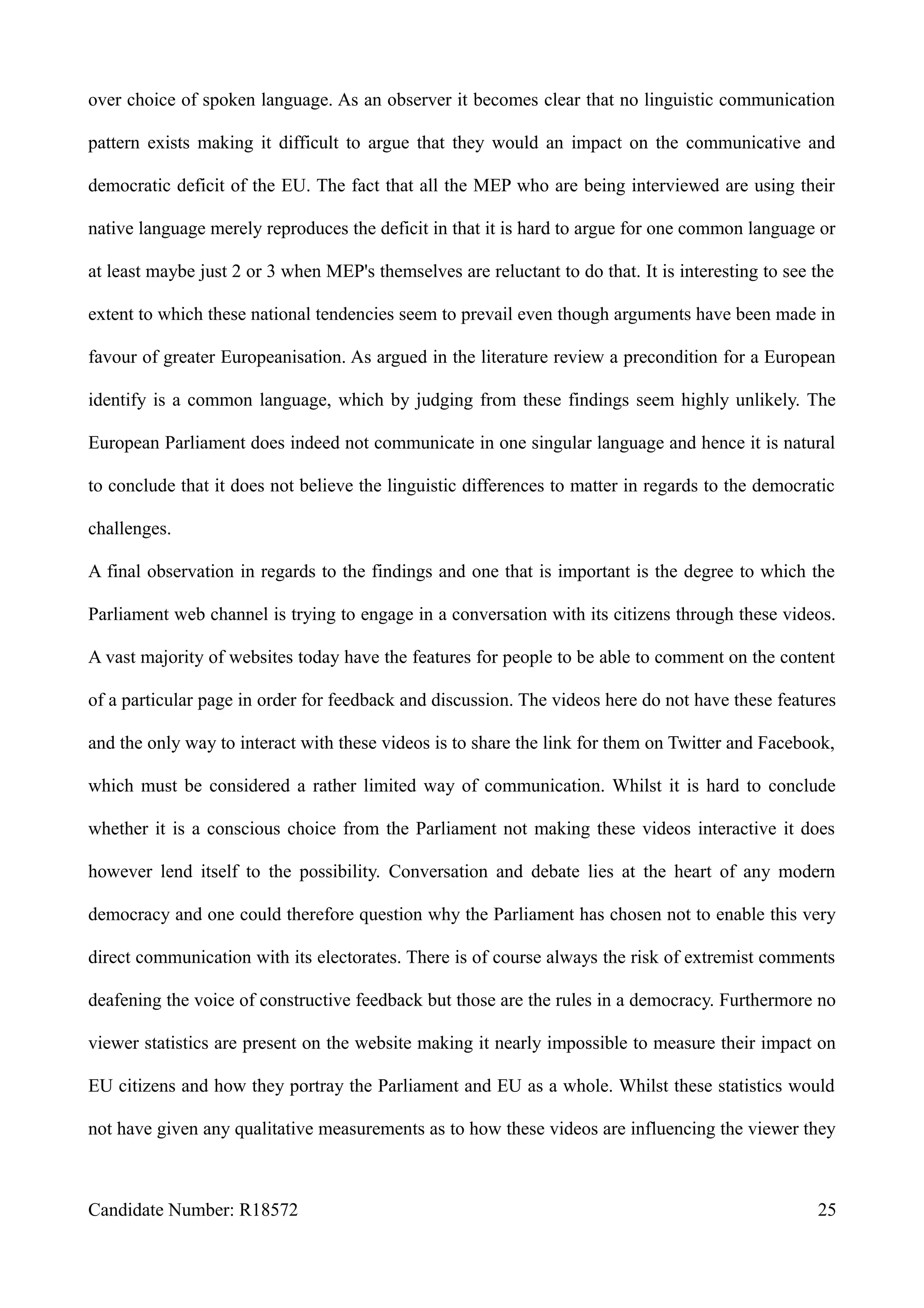
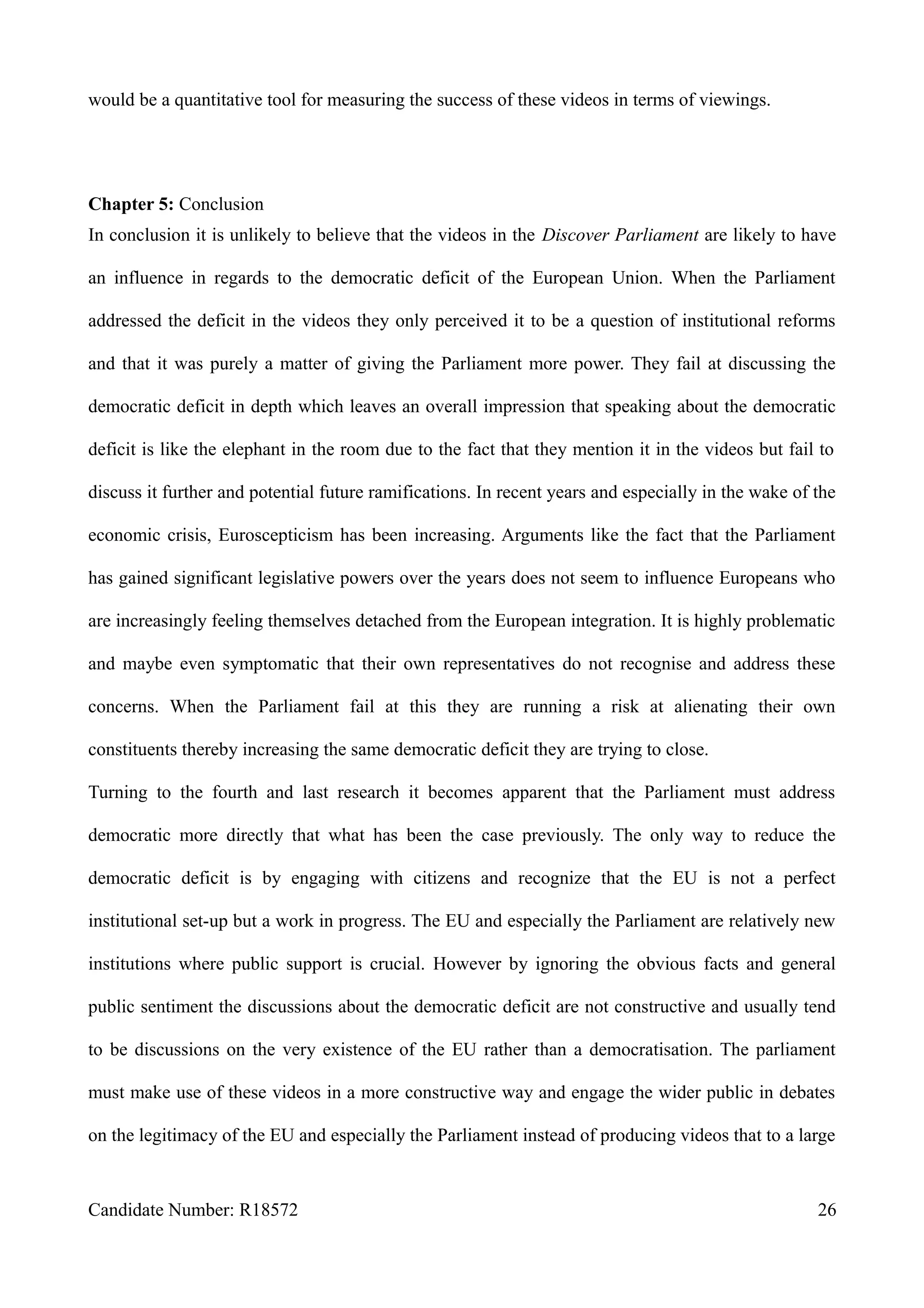
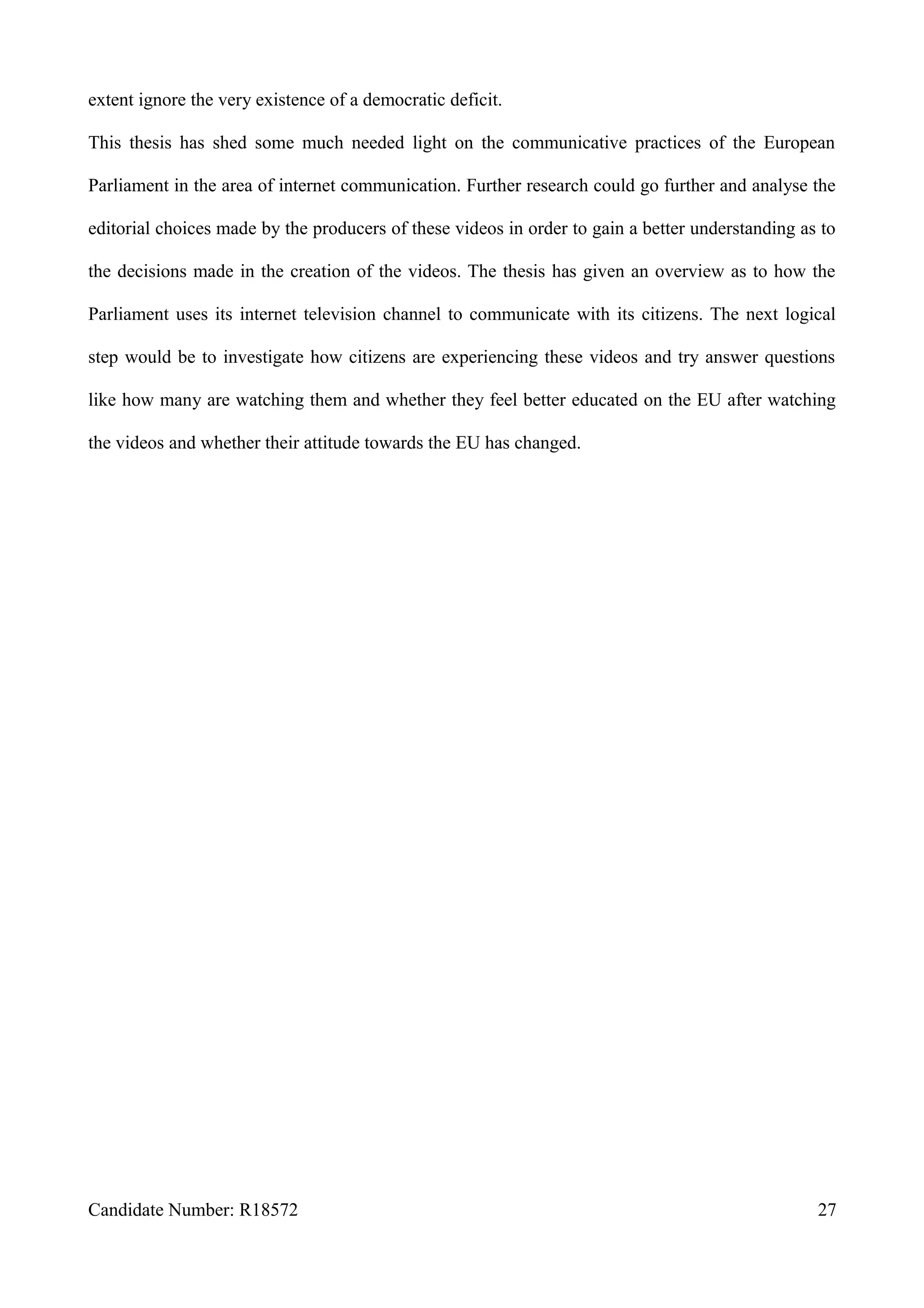
![Chapter 6: References
Andersen, S.S., Eliassen, K.A., 1996. The European Union: How Democratic Is It? SAGE.
Anderson, C.J., Reichert, M.S., 1995. Economic Benefits and Support for Membership in the
E.U.: A Cross-National Analysis. Journal of Public Policy 15, 231–249.
Bache, I., George, S., Bulmer, S., 2011. Politics in the European Union, 3 edition. ed. OUP
Oxford.
Bellamy, R., 2010. Democracy without democracy? Can the EU’s democratic “outputs” be
separated from the democratic “inputs” provided by competitive parties and majority rule?
Journal of European Public Policy 17, 2–19.
Bellamy, R., 2013. “An Ever Closer Union Among the Peoples of Europe”: Republican
Intergovernmentalism and Demoicratic Representation within the EU. Journal of European
Integration 35, 499–516.
Blumler, J.G., Gurevitch, M., 1995. The Crisis of Public Communication. Psychology Press.
Boomgaarden, H.G., Vliegenthart, R., de Vreese, C.H., Schuck, A.R.T., 2010. News on the
move: exogenous events and news coverage of the European Union. Journal of European
Public Policy 17, 506–526.
Bruter, M., 2003. Winning hearts and minds for Europe: the impact of news and symbols on civic
and cultural European identity. Comparative political studies 36.
Buzek, J., 2011. State of the Union: Three Cheers for the Lisbon Treaty and Two Warnings for
Political Parties. JCMS: Journal of Common Market Studies 49, 7–18.
Commission of the European Communities 2006 White Paper on a European Communication
Policy, Brussels, COM (2006) 35 final.
Cappella, J.N., Jamieson, K.H., 1997. Spiral of cynicism: the press and the public good. Oxford
University Press, New York.
Cohen, L., Manion, L., Morrison, K., 2011. Research methods in education. Routledge, London;
New York.
Cooper, I., 2011. The euro crisis as the revenge of neo-functionalism [WWW Document]. URL
http://euobserver.com/opinion/113682 (accessed 7.29.13).
Council of the European Communities 1989 Council Directive 89/552/EEC of 3
October 1989 on the Coordination of Certain Provisions Laid Down by Law,
Regulation or Administrative Action in Member States Concerning the Pursuit of
Television Broadcasting Activities; at: http://eur-
lex.europa.eu/LexUriServ/site/en/consleg/1989/L/01989L0552-19970730-en.pdf (accessed
10 August 2013).
Council of the European Communities 1997. Directive 97/36/EC of the European
Parliament and of the Council of 30 June 1997 amending Council Directive
89/552/EEC on the Coordination of Certain Provisions Laid Down by Law,
Regulation or Administrative Action in Member States Concerning the Pursuit
of Television Broadcasting Activities; at: http://eur-
lex.europa.eu/LexUriServ/LexUriServ.douri=celex:31997L0036:en:html (accessed 16
August 2013).
Creswell, J.W., 1994. Research design: qualitative & quantitative approaches. Sage Publications.
Crombez, C., 2003. The Democratic Deficit in the European Union Much Ado about Nothing?
European Union Politics 4, 101–120.
D’Haenens, L., 2005. Euro-Vision The Portrayal of Europe in the Quality Press. Gazette 67, 419–
440.
De Vreese, C.H., 2007. The EU as a public sphere. Living Reviews in European Governance 2.
Dyer, C., 1995. Beginning research in psychology: a practical guide to research methods and
statistics [...] [...]. Blackwell, Oxford [u.a.
Candidate Number: R18572 28](https://image.slidesharecdn.com/bfd0212e-65f4-4f9f-b226-7bf98da9cf95-160126224354/75/Max_Genske_Dissertation-27-2048.jpg)
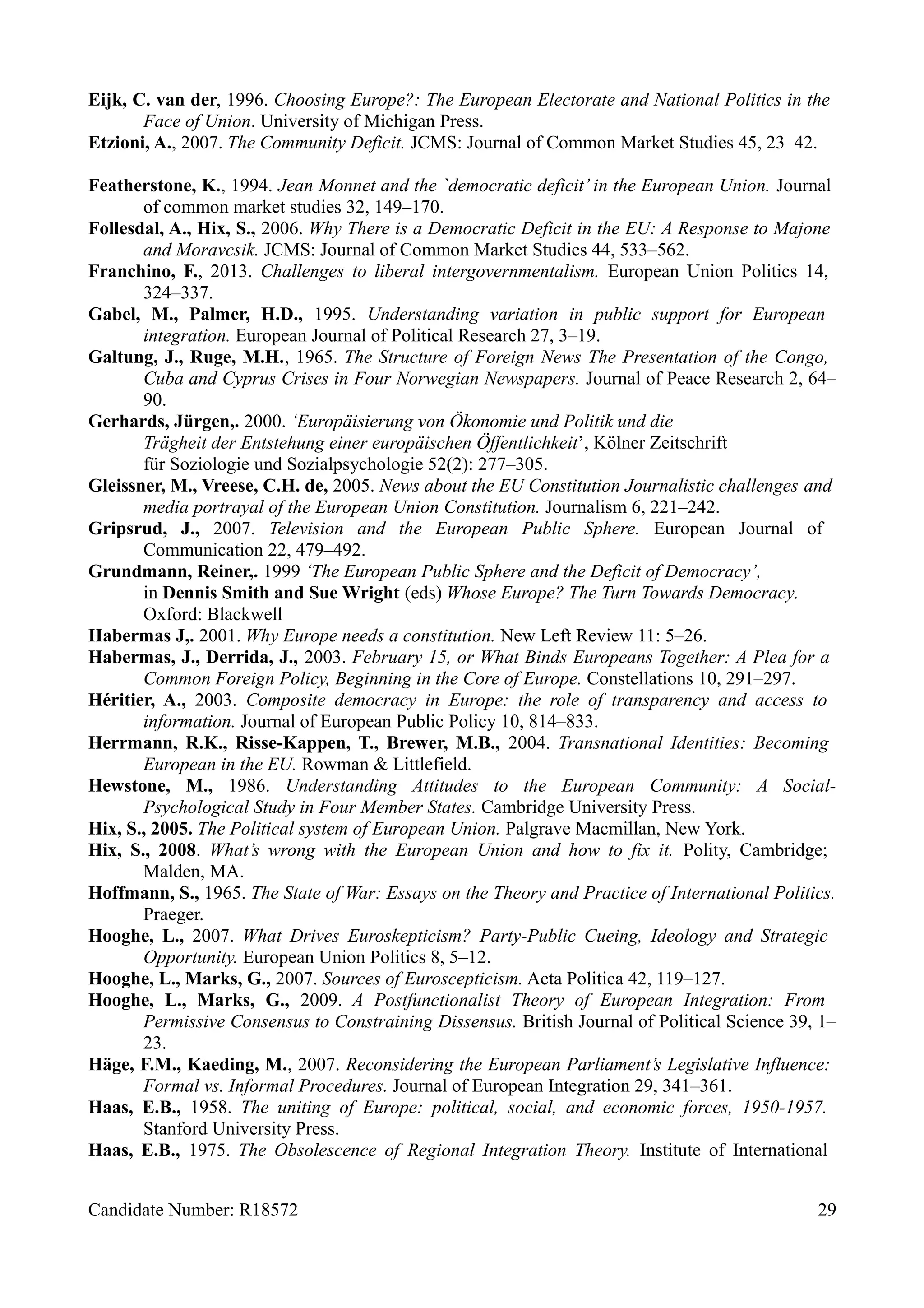
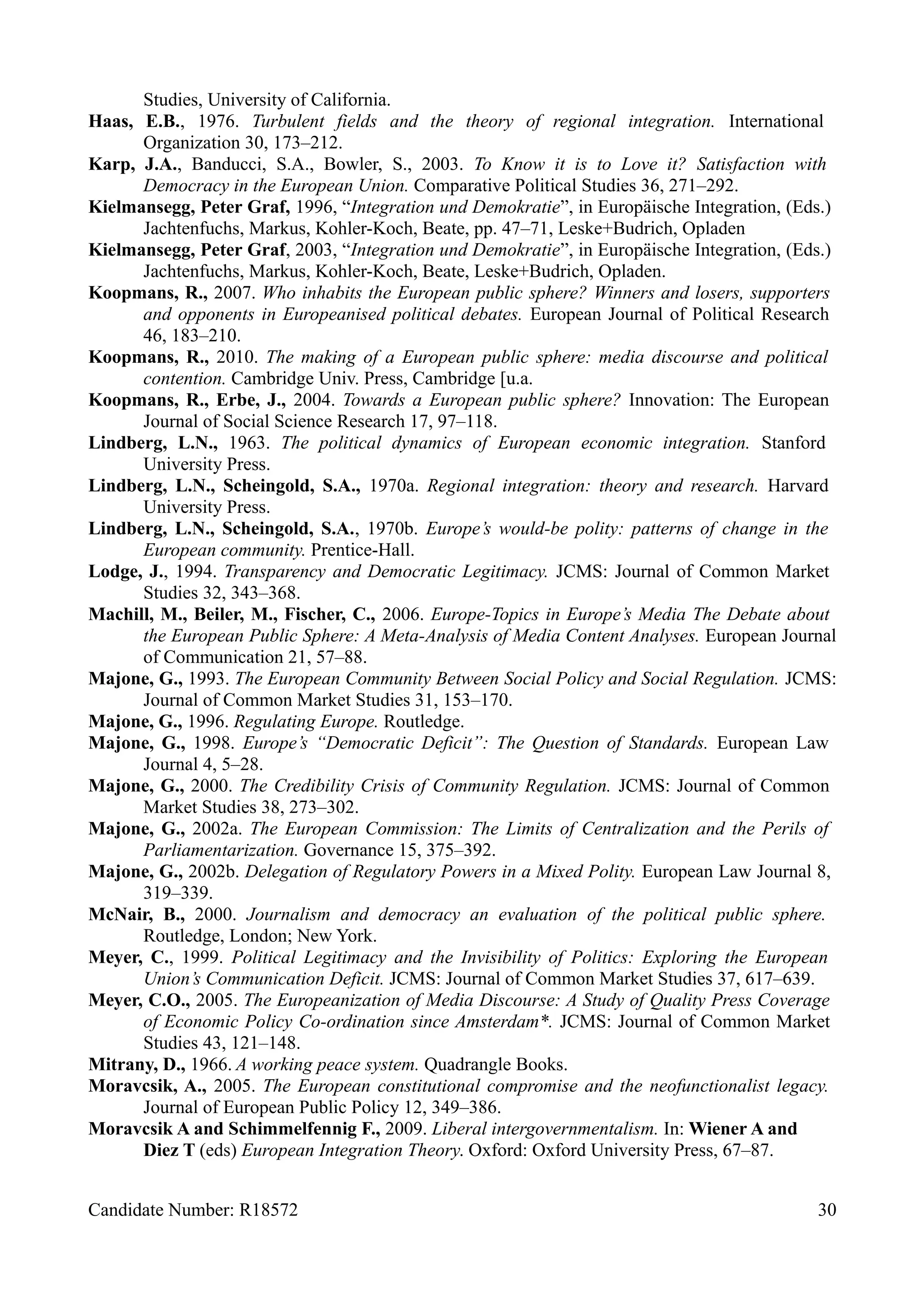
![Nisbet, J. and Watt, J. 1984. Case study in J. Bell, T. Bush, A. Fox, J. Goodey and S. Goulding
(eds) Conducting Small-Scale Investigations in Educational Management, London: Harper
and Row, 79-92
Noije, L. van, 2010. The European paradox: A communication deficit as long as European
Integration steals the headlines. European Journal of Communication 25, 259–272.
Norris, P., 2000. A Virtuous Circle: Political Communications in Postindustrial Societies.
Cambridge University Press.
Olausson, U., 2010. Towards a European identity? The news media and the case of climate
change. European Journal of Communication 25, 138–152.
Page, B.I., Shapiro, R.Y., 1992. The Rational public: fifty years of trends in Americans’ policy
preferences. The University of Chicago Press, Chicago, [etc.].
Patterson, Thomas E. 1994. Out of Order. New York: Vintage Books.
Peter, J., Vreese, C.H. de, 2004. In Search of Europe A Cross-National Comparative Study of the
European Union in National Television News. The Harvard International Journal of
Press/Politics 9, 3–24.
Pollack, M.A., 1994. Creeping Competence: The Expanding Agenda of the European Community.
Journal of Public Policy 14, 95–145.
Pollack, M.A., 2000. The End of Creeping Competence? EU Policy-Making Since Maastricht.
JCMS: Journal of Common Market Studies 38, 519–538.
Price, M.E., 1995. Television, the Public Sphere, and National Identity. Oxford University Press.
Reif, K., Schmitt, H., 1980. Nine Second-Order National Elections – a Conceptual Framework for
the Analysis of European Election Results. European Journal of Political Research 8, 3–44.
Rhinard, M., 2002. The Democratic Legitimacy of the European Union Committee System (SSRN
Scholarly Paper No. ID 2193952). Social Science Research Network, Rochester, NY.
Risse, T., 2005. Neofunctionalism, European identity, and the puzzles of European integration.
Journal of European Public Policy 12, 291–309.
Risse-kappen, T., 1996. Exploring the Nature of the Beast: International Relations Theory and
Comparative Policy Analysis Meet the European Union. JCMS: Journal of Common Market
Studies 34, 53–80.
Risse-Kappen, T., 2010. A community of Europeans?: transnational identities and public spheres.
Cornell University Press, Ithaca [N.Y.].
Sandholtz, W., Sweet, A.S., 1998. European Integration and Supranational Governance. Oxford
University Press, USA.
Scharpf, F.W., 1997. Economic integration, democracy and the welfare state. Journal of European
public policy 4, 18–36.
Scharpf, F.W., 1999. Governing in Europe: Effective and Democratic? Oxford University Press.
Schlesinger, P., 2003. The Babel of Europe? An Essay on Networks and Communicative Spaces
(ARENA Working Paper No. 22). ARENA.
Schmidt, V.A., 2013. Democracy and Legitimacy in the European Union Revisited: Input, Output
and “Throughput”. Political Studies 61, 2–22.
Schmitt, H., 2005. The European Parliament Elections of June 2004: Still Second-Order? West
European Politics 28, 650–679.
Schuck, A.R.T., De Vreese, C.H., 2011. Public Support for Referendums: The Role of the Media.
West European Politics 34, 181–207.
Schuck, A.R.T., Vreese, C.H. de, 2006. Between Risk and Opportunity News Framing and its
Effects on Public Support for EU Enlargement. European Journal of Communication 21, 5–
32.
Shackleton, M., Raunio, T., 2003. Codecision since Amsterdam: a laboratory for institutional
innovation and change. Journal of European Public Policy 10, 171–188.
Shaughnessy, J.J., Zechmeister, E.B., Zechmeister, J.S., 2003. Research methods in psychology.
Candidate Number: R18572 31](https://image.slidesharecdn.com/bfd0212e-65f4-4f9f-b226-7bf98da9cf95-160126224354/75/Max_Genske_Dissertation-30-2048.jpg)
![McGraw-Hill Higher Education.
Stockemer, D., 2012. Citizens’ support for the European Union and participation in European
Parliament elections. European Union Politics 13, 26–46.
Street, J., 2001. Mass media, politics and democracy. Palgrave, Houndmills, Hampshire.
Sweet, A.S., Sandholtz, W., Fligstein, N., 2001. The Institutionalization of Europe. Oxford
University Press.
Sweet, S., Alec, Sandholtz, W., 2010. Neofunctionalism and Supranational Governance (SSRN
Scholarly Paper No. ID 1585123). Social Science Research Network, Rochester, NY.
The European Parliament 2013 EuroparlTV: About Us [WWW Document], n.d. URL
http://europarltv.europa.eu/en/about-europarltv/about-us.aspx (accessed 9.12.13).
Thomassen, J.J., 1999. Political representation and legitimacy in the European Union. Oxford
University Press.
Trenz, H., 2008. Understanding Media Impact on European Integration: Enhancing or Restricting
the Scope of Legitimacy of the EU? Journal of European Integration 30, 291–309.
Tumber, H. 1995. ‘Marketing Maastricht: The EU and News Management’. Media,
Culture Society, Vol. 17, pp. 511–19
Viktoria Kaina, Ireneusz Pawel Karolewski, 2009. EU governance and European identity.
Living Reviews in European Governance 4.
Vliegenthart, R., Schuck, A.R.T., Boomgaarden, H.G., Vreese, C.H.D., 2008. News Coverage
and Support for European Integration, 1990–2006. Int J Public Opin Res 20, 415–439.
Vreese, C.H. de, 2001. `Europe’ in the News A Cross-National Comparative Study of the News
Coverage of Key EU Events. European Union Politics 2, 283–307.
Weiler, J.H.H., 2012. In the Face of Crisis: Input Legitimacy, Output Legitimacy and the Political
Messianism of European Integration. Journal of European Integration 34, 825–841.
WelHer, H., 2008. Transnationalization of public spheres. Palgrave Macmillan, Basingstoke.
Zaller, J., Feldman, S., 1992. A simple theory of the survey response: Answering questions versus
revealing preferences. American journal of political science 579–616.
Zweifel, T.D., 2002. ...Who is without sin cast the first stone: the EU’s democratic deficit in
comparison. Journal of European Public Policy 9, 812–840.
Yin, R.K., 2009. Case Study Research: Design and Methods. SAGE.
Candidate Number: R18572 32](https://image.slidesharecdn.com/bfd0212e-65f4-4f9f-b226-7bf98da9cf95-160126224354/75/Max_Genske_Dissertation-31-2048.jpg)
